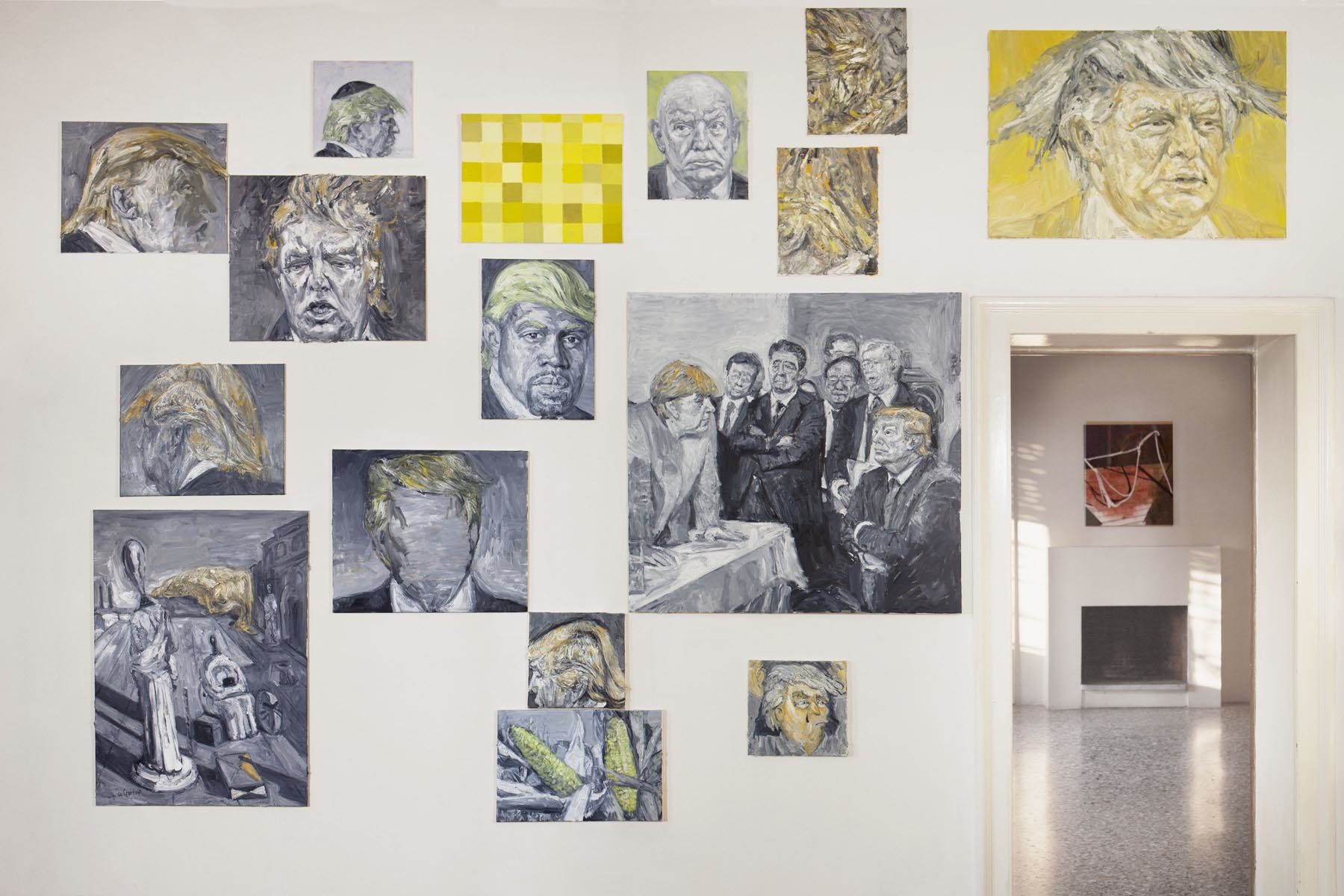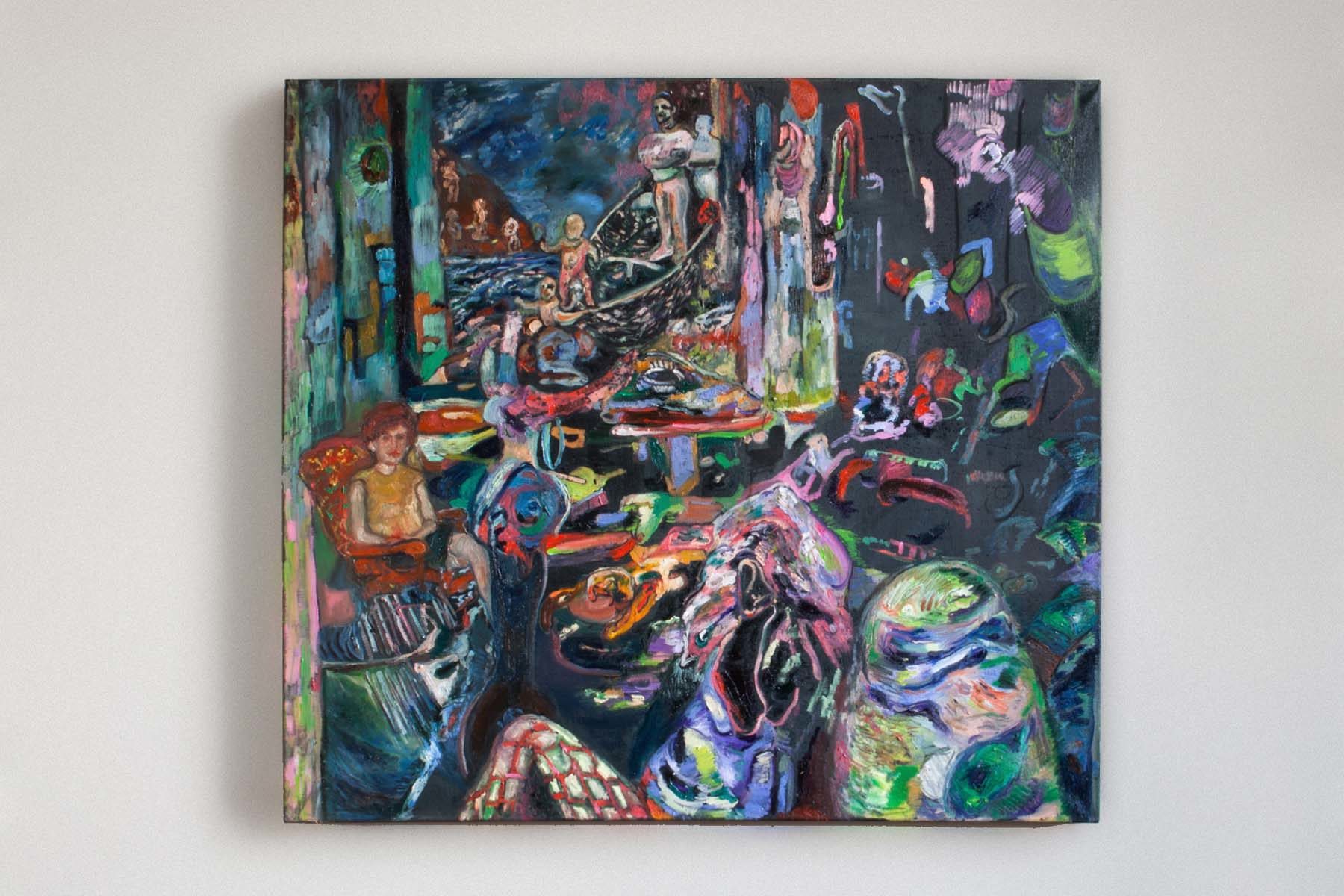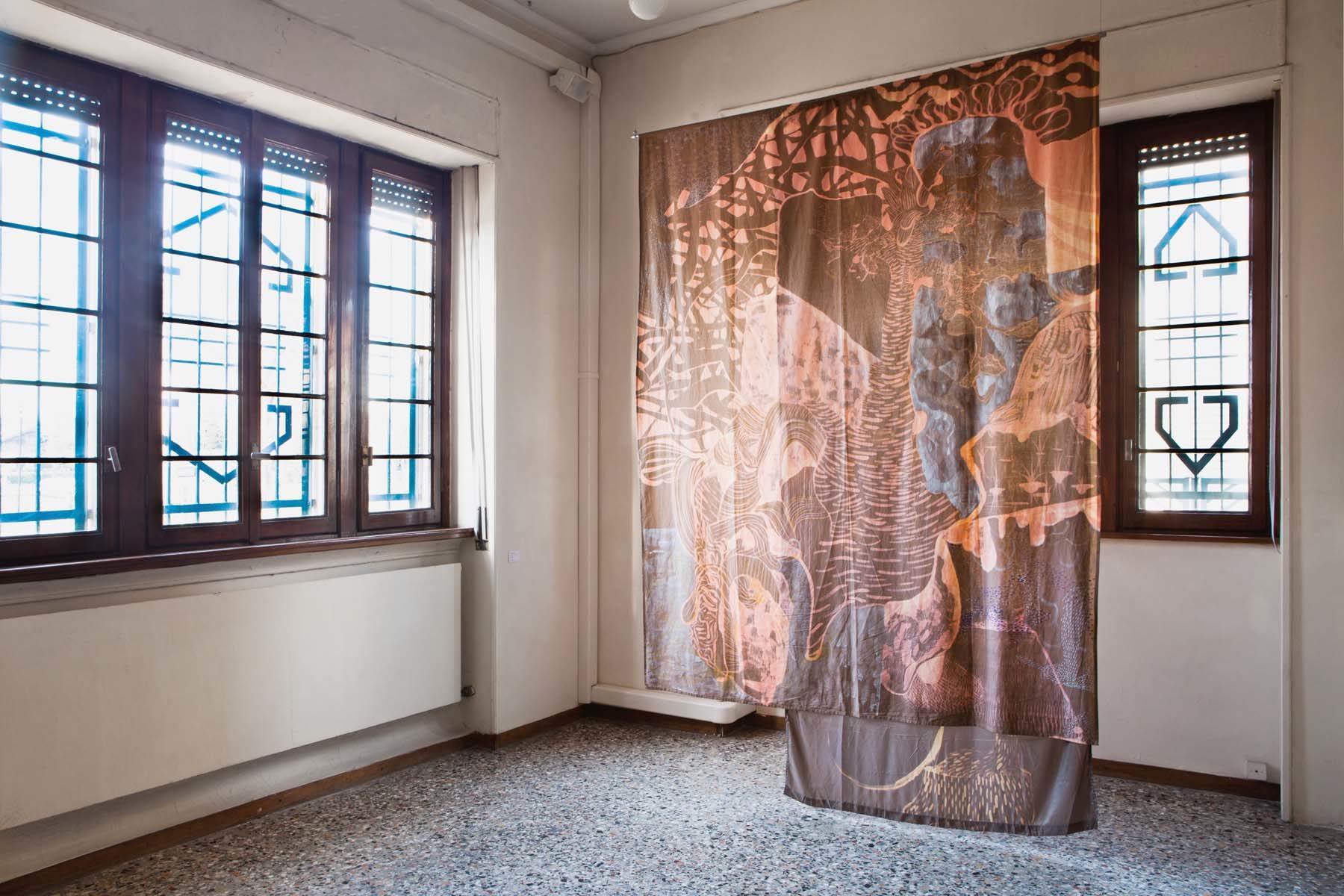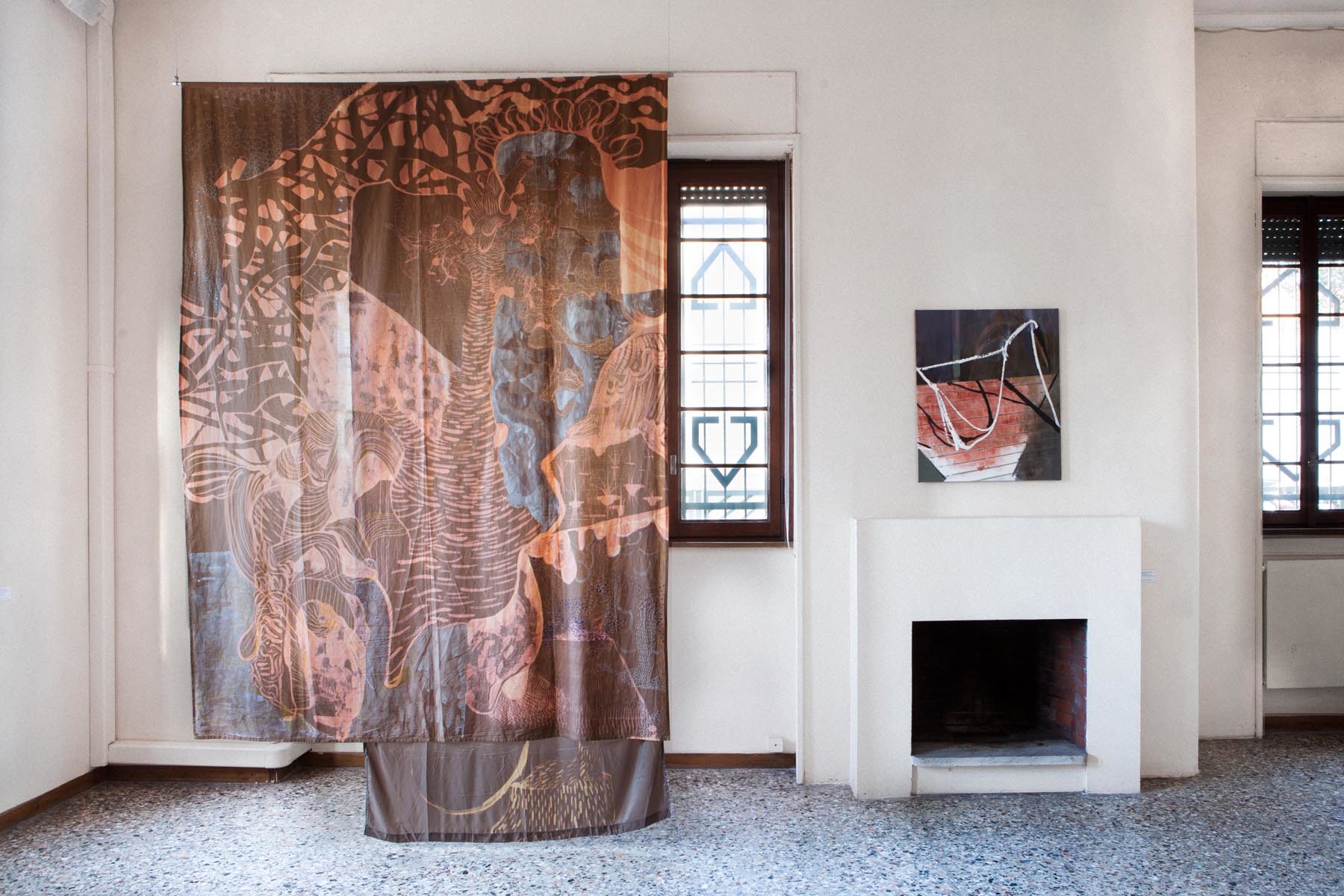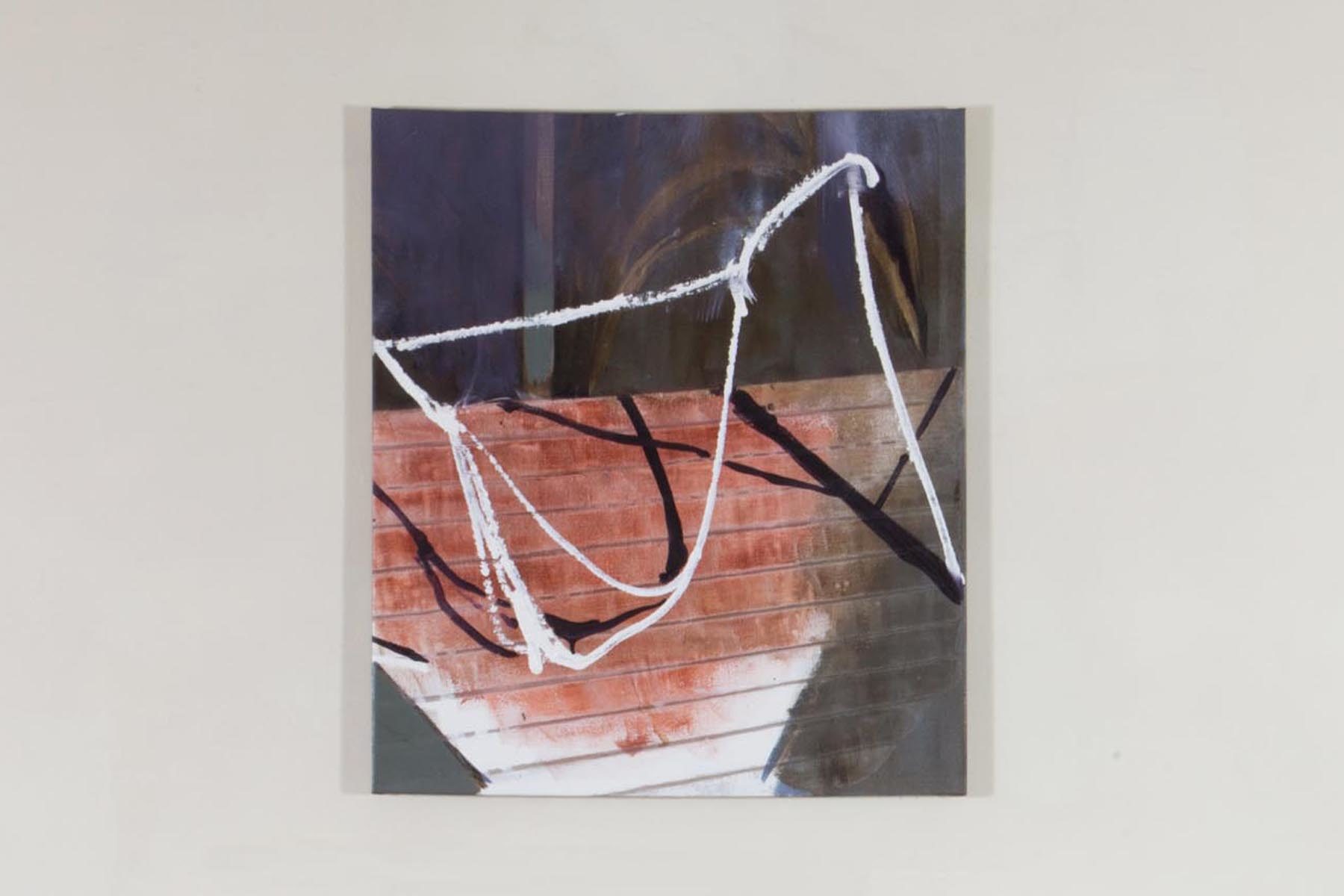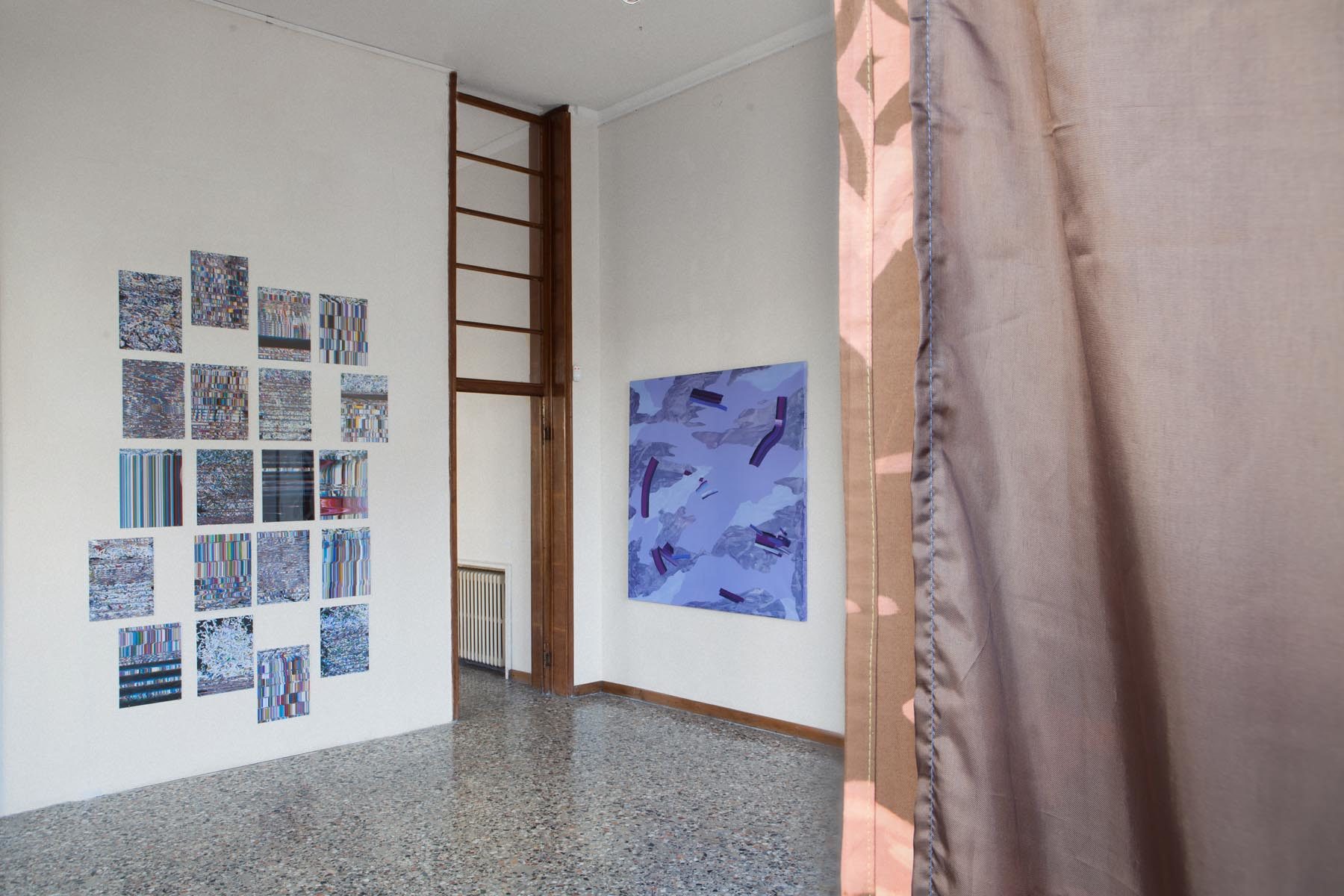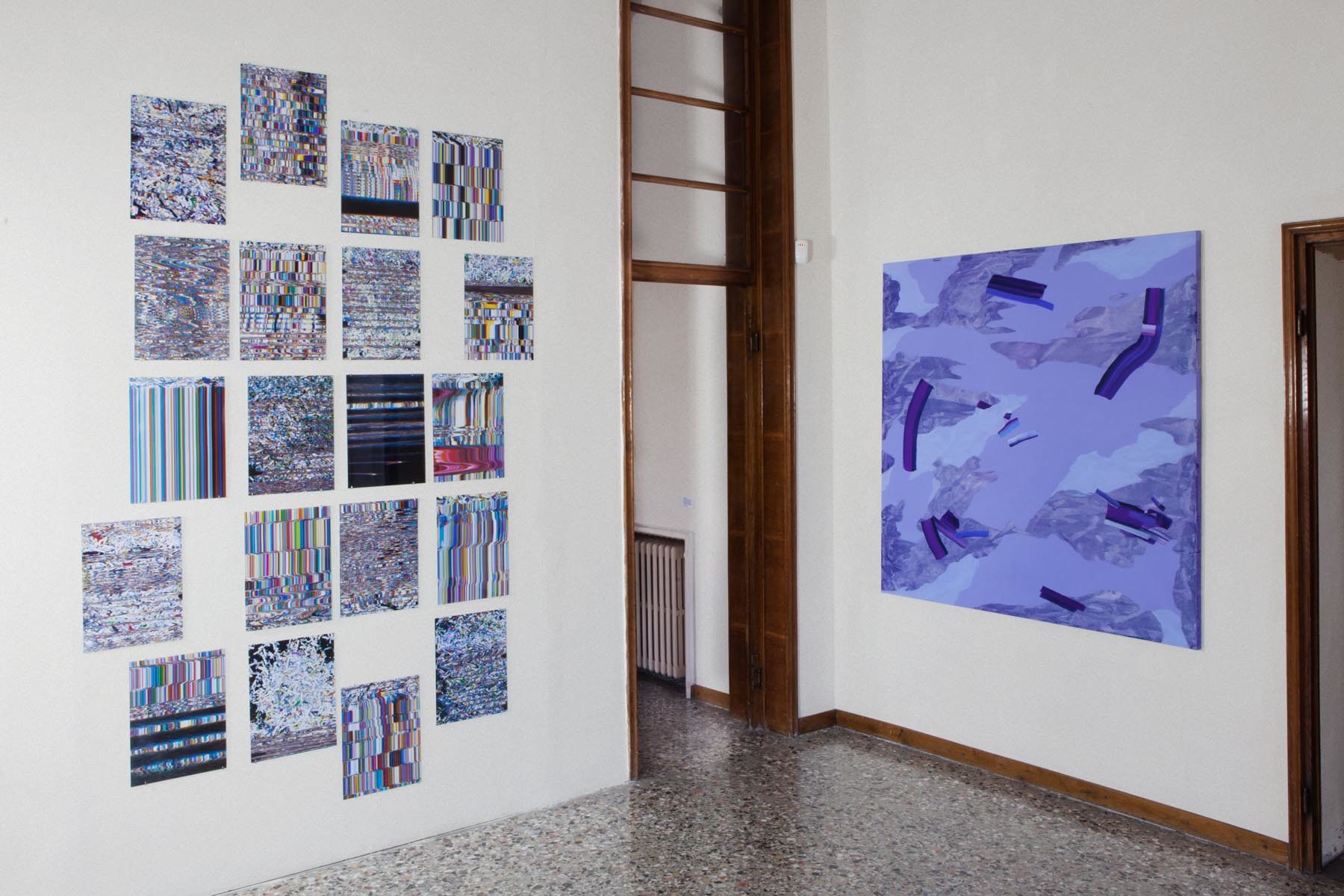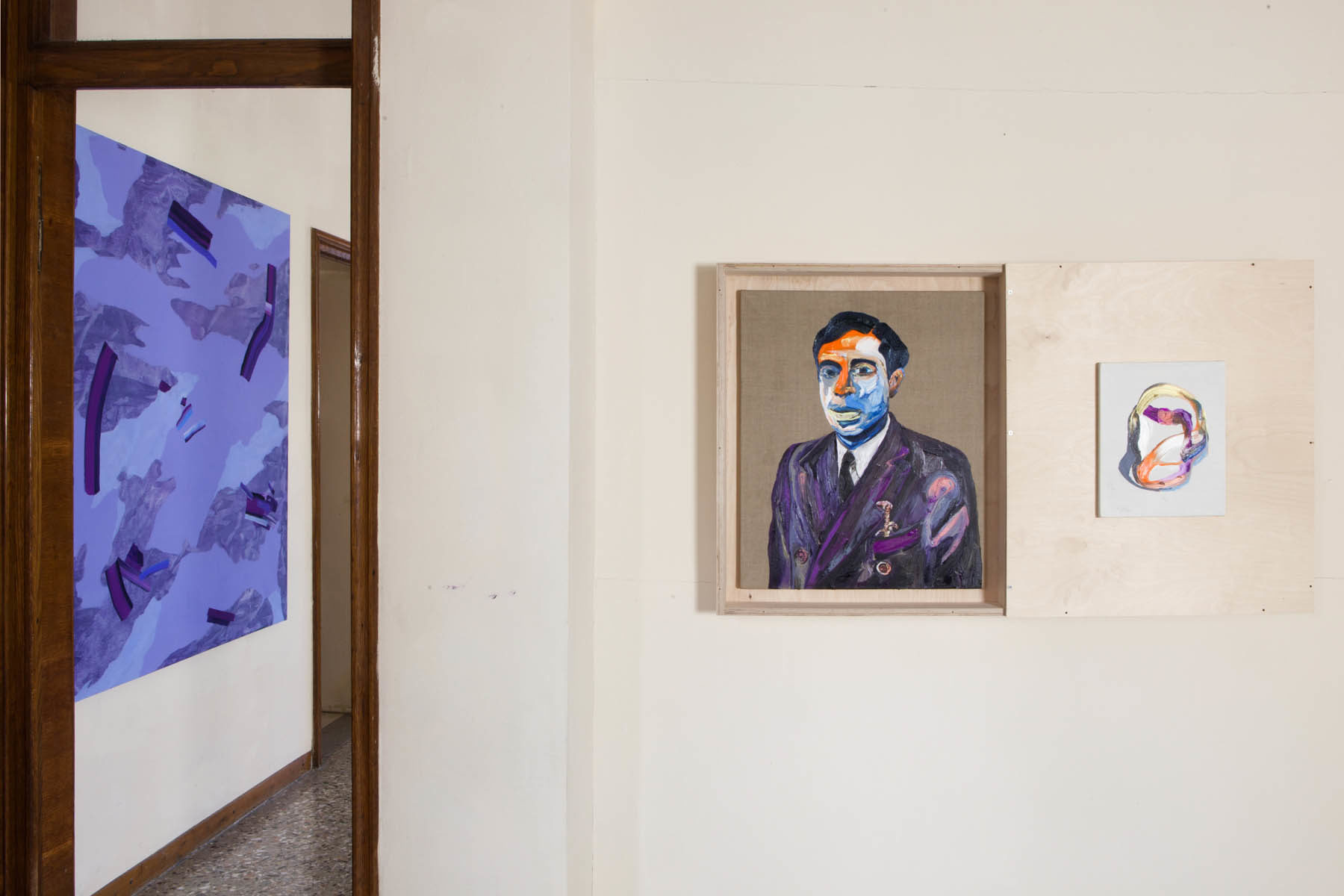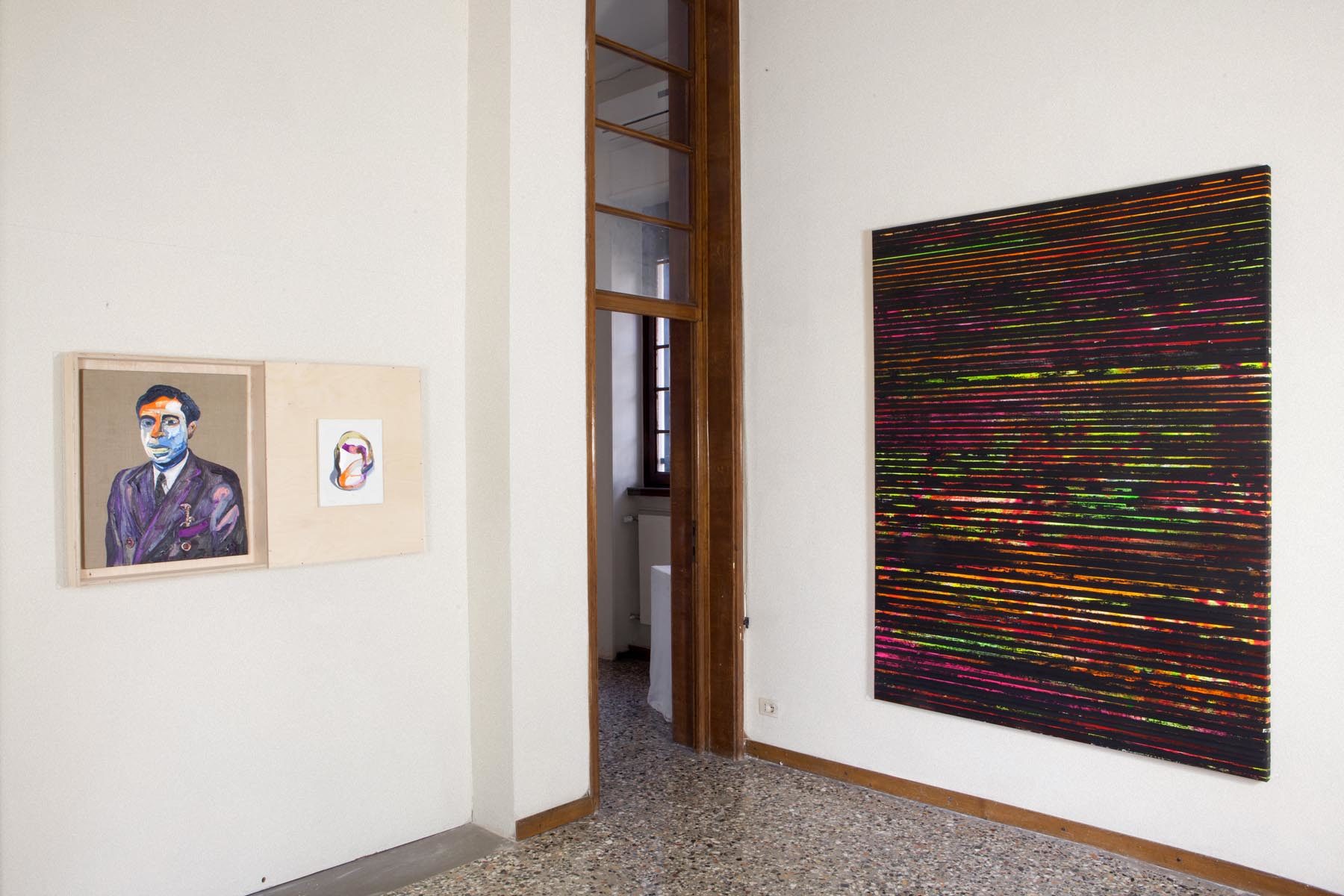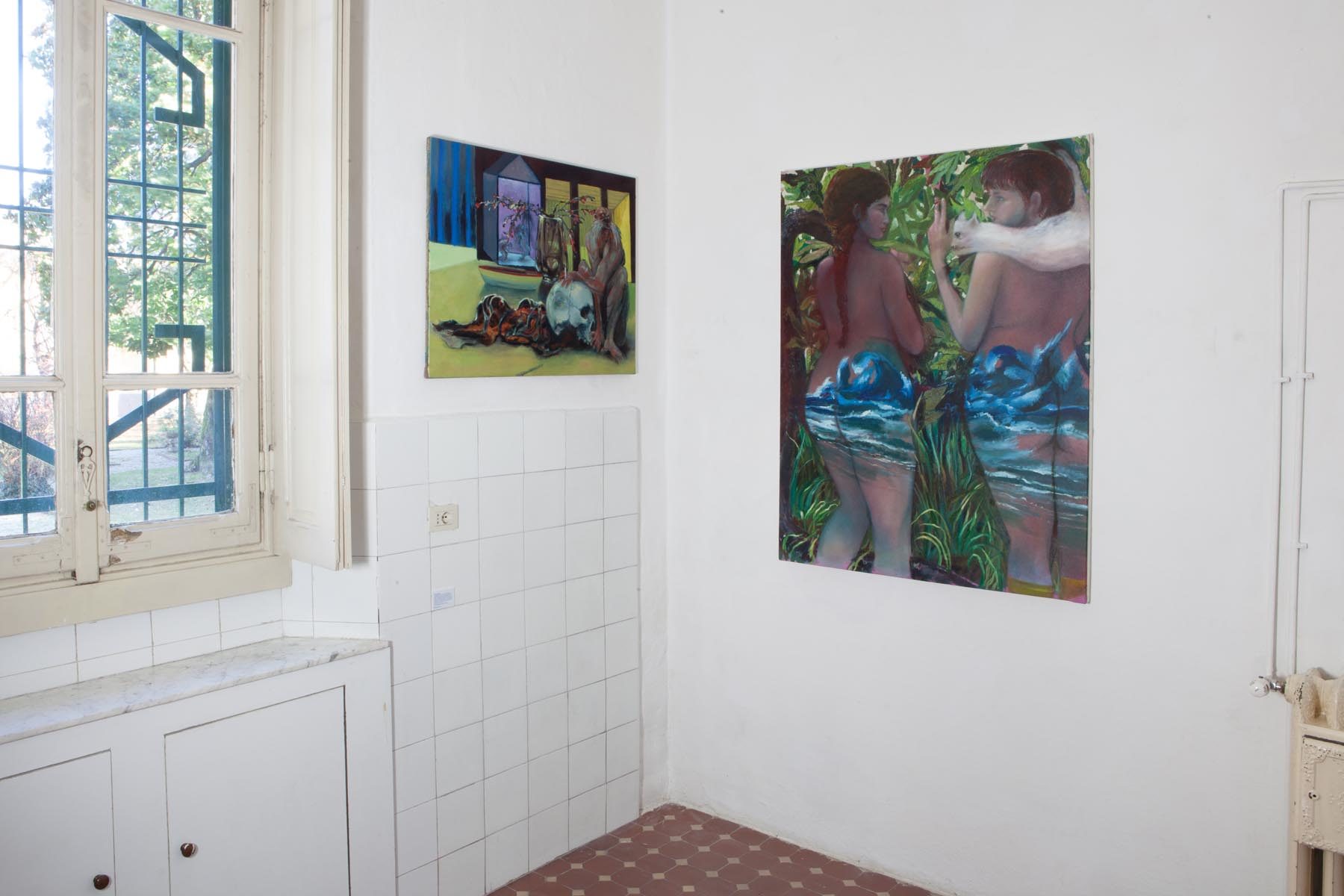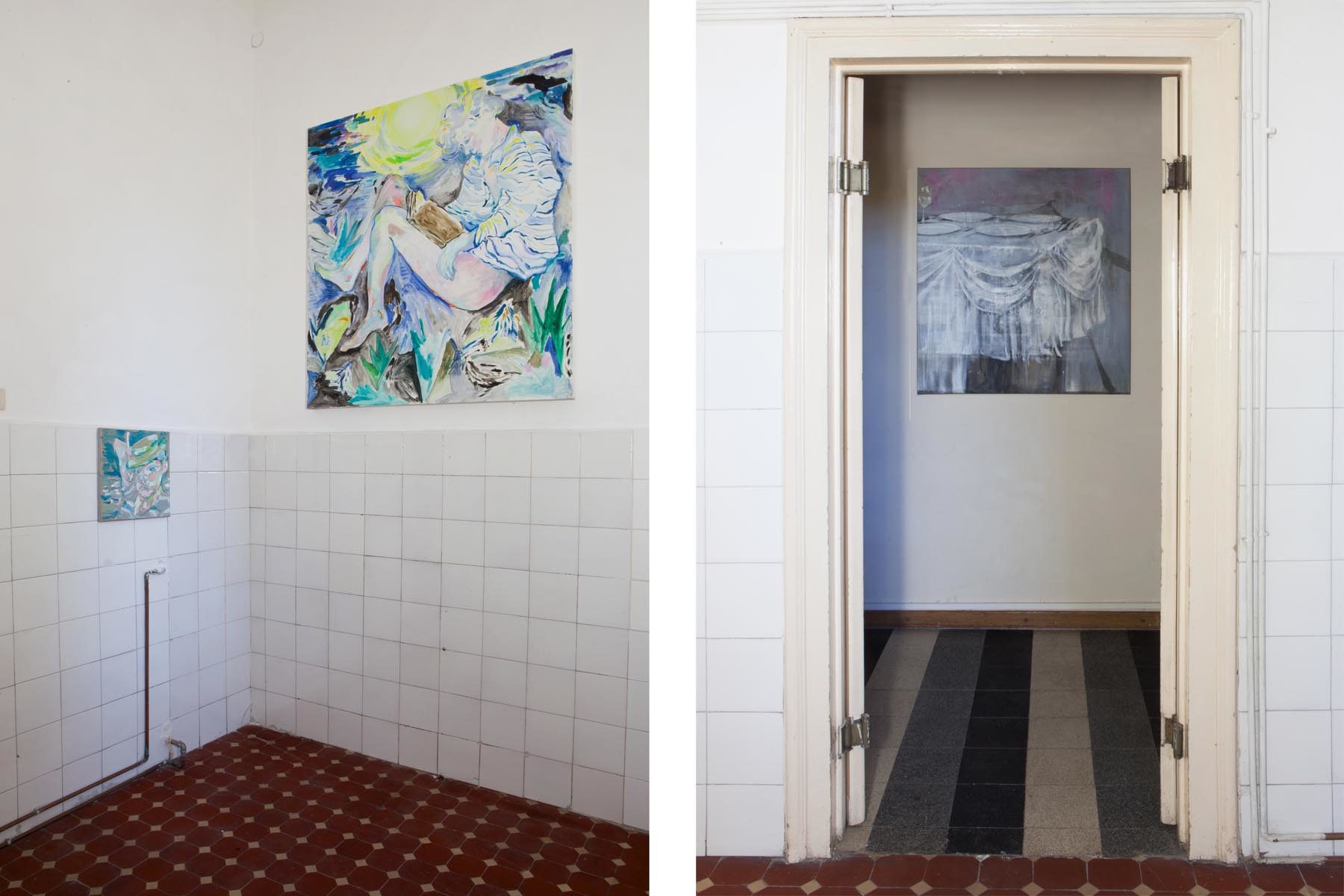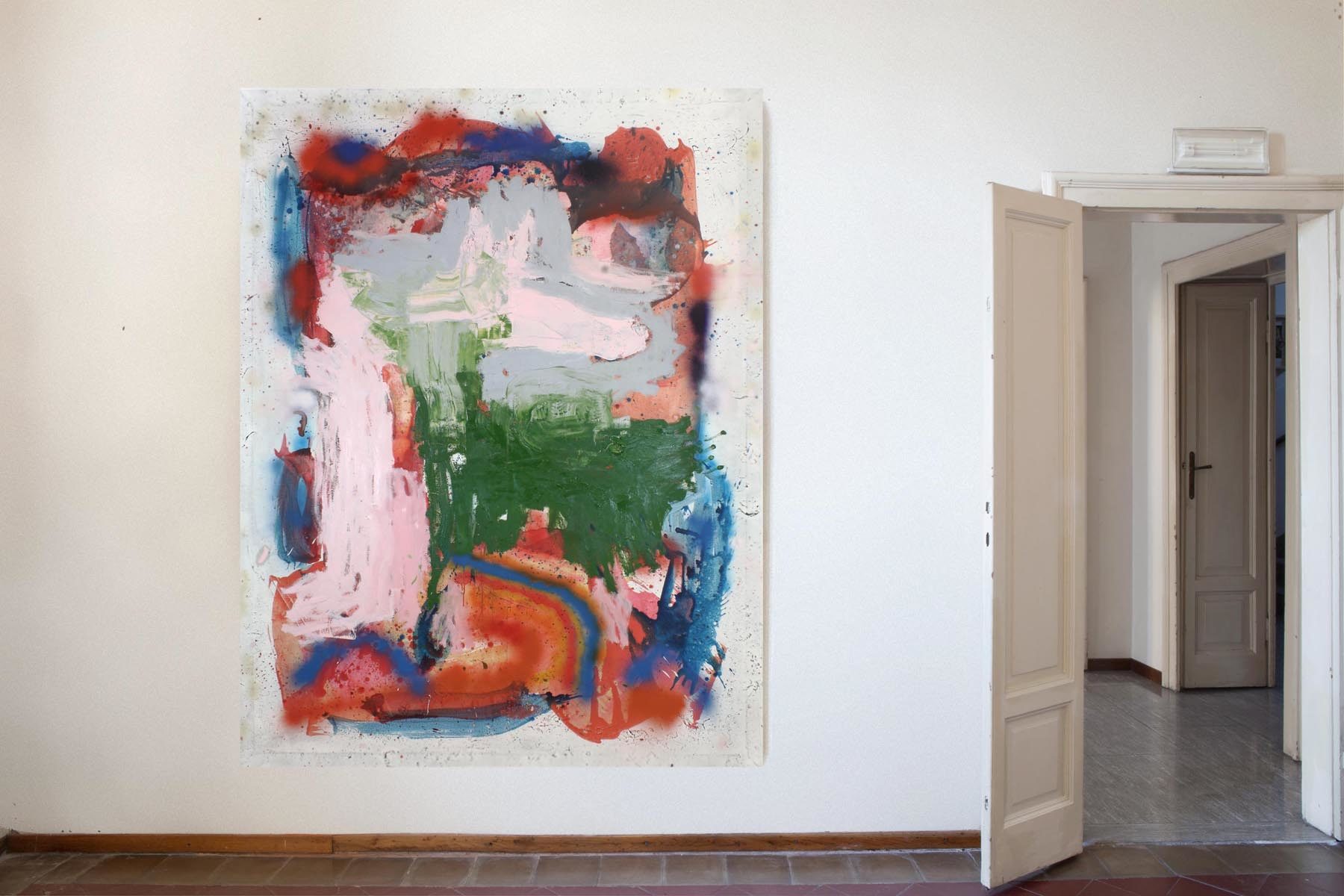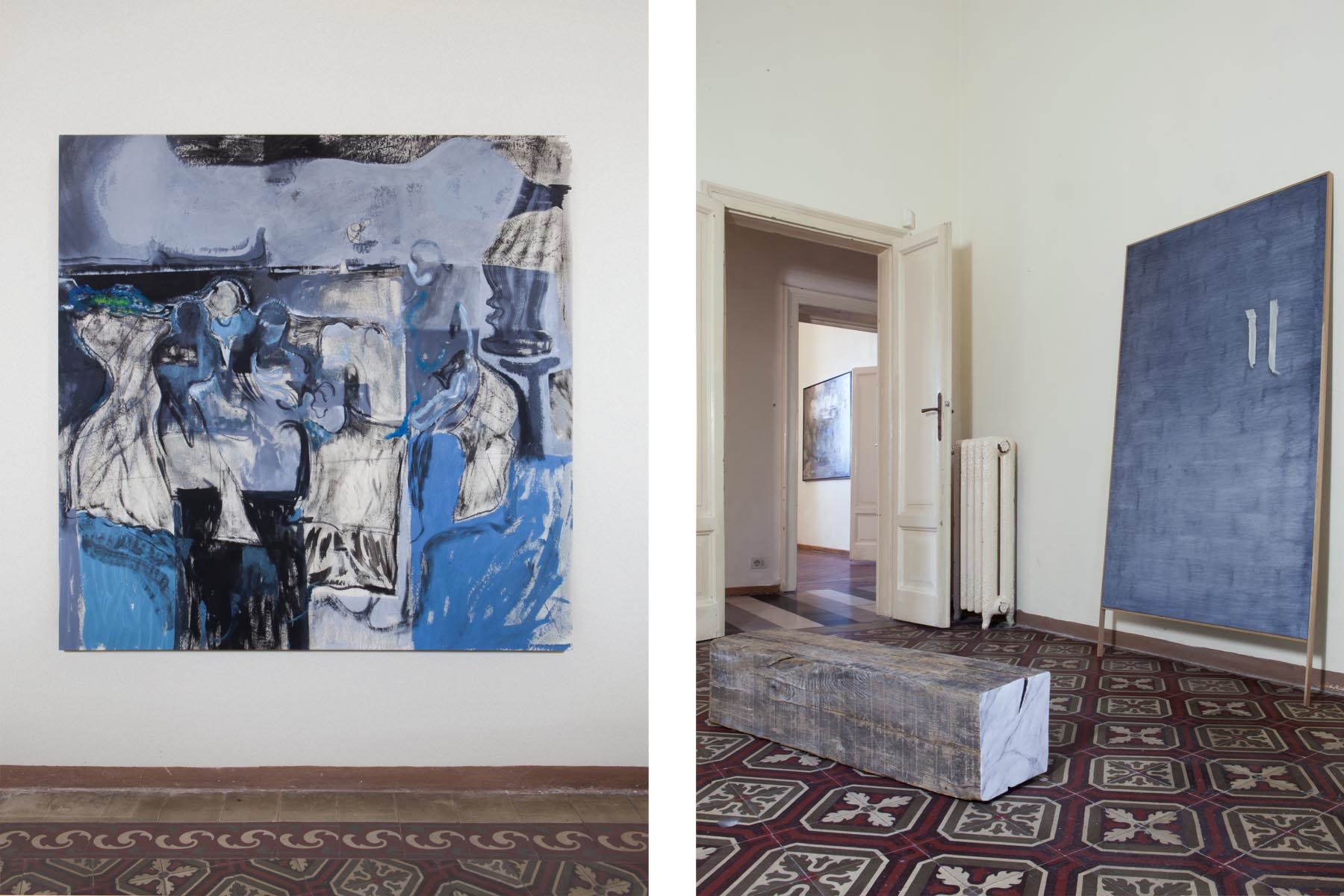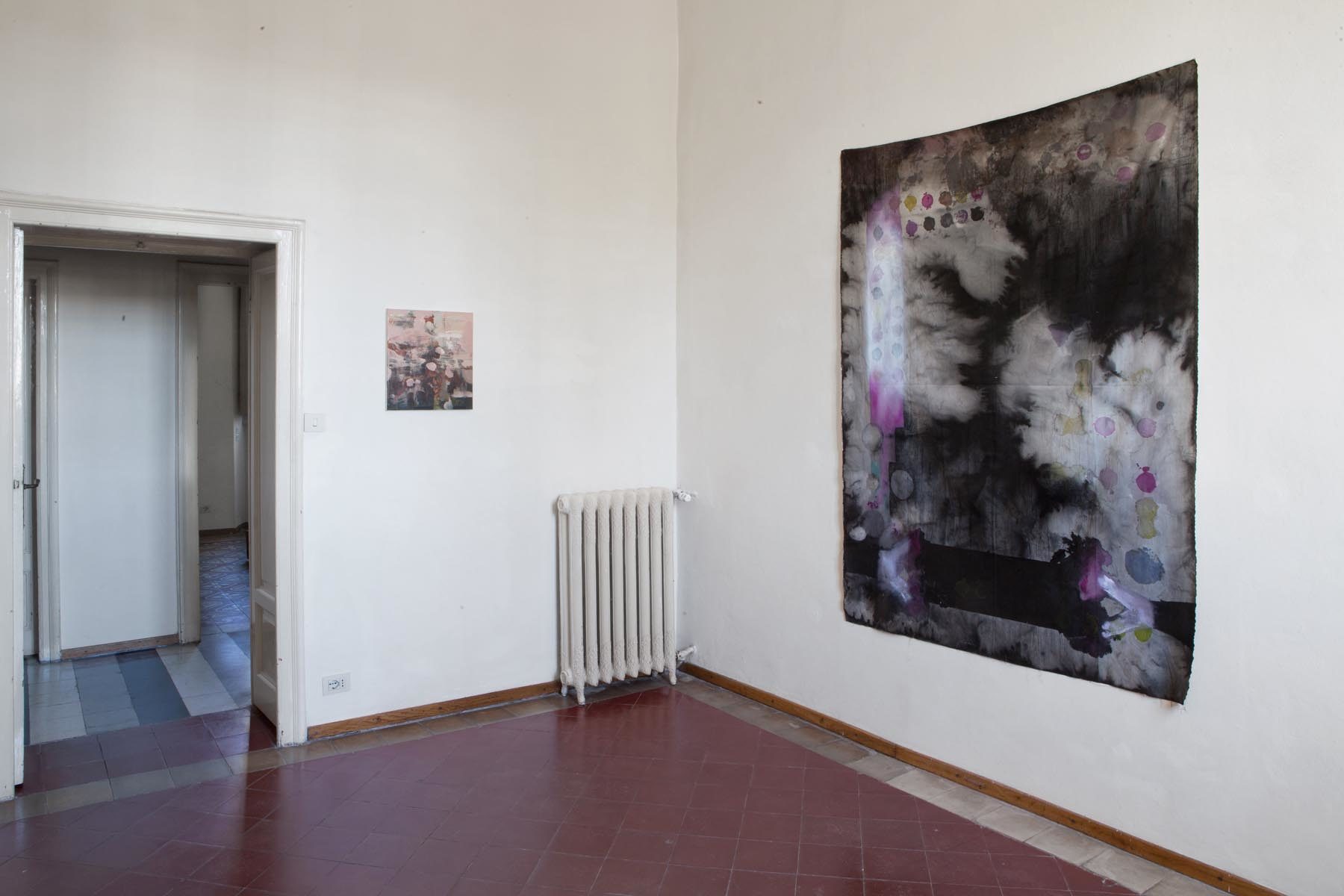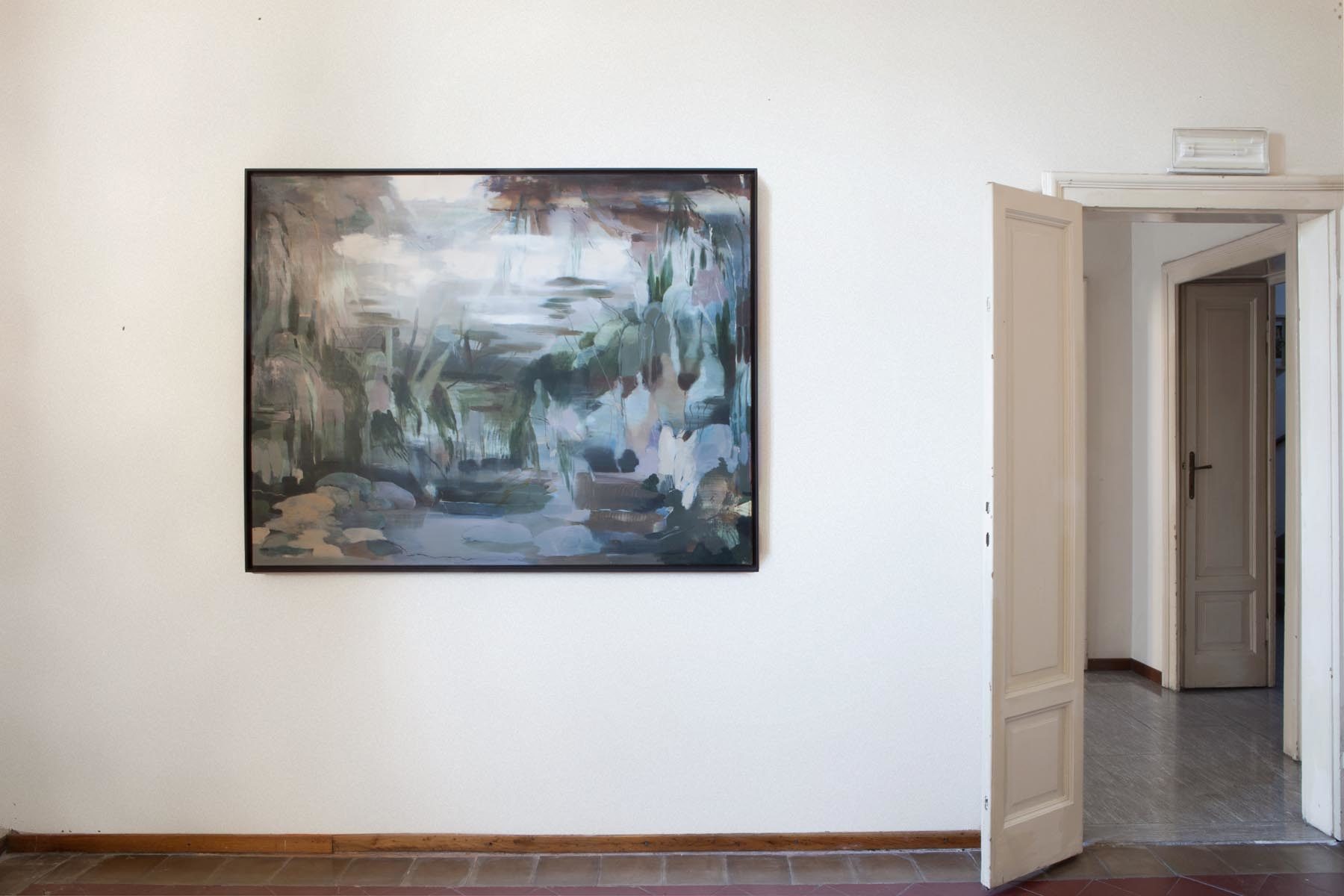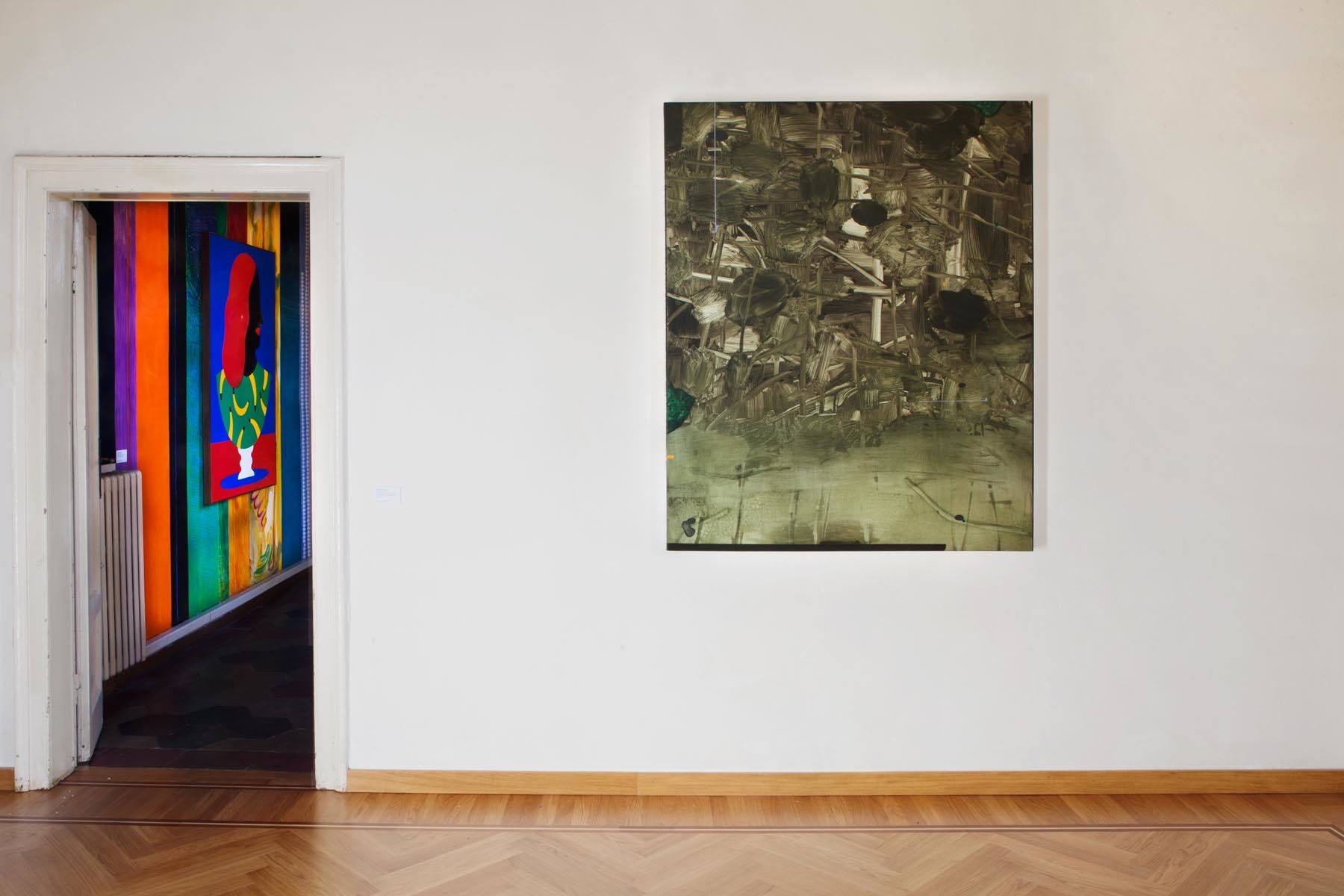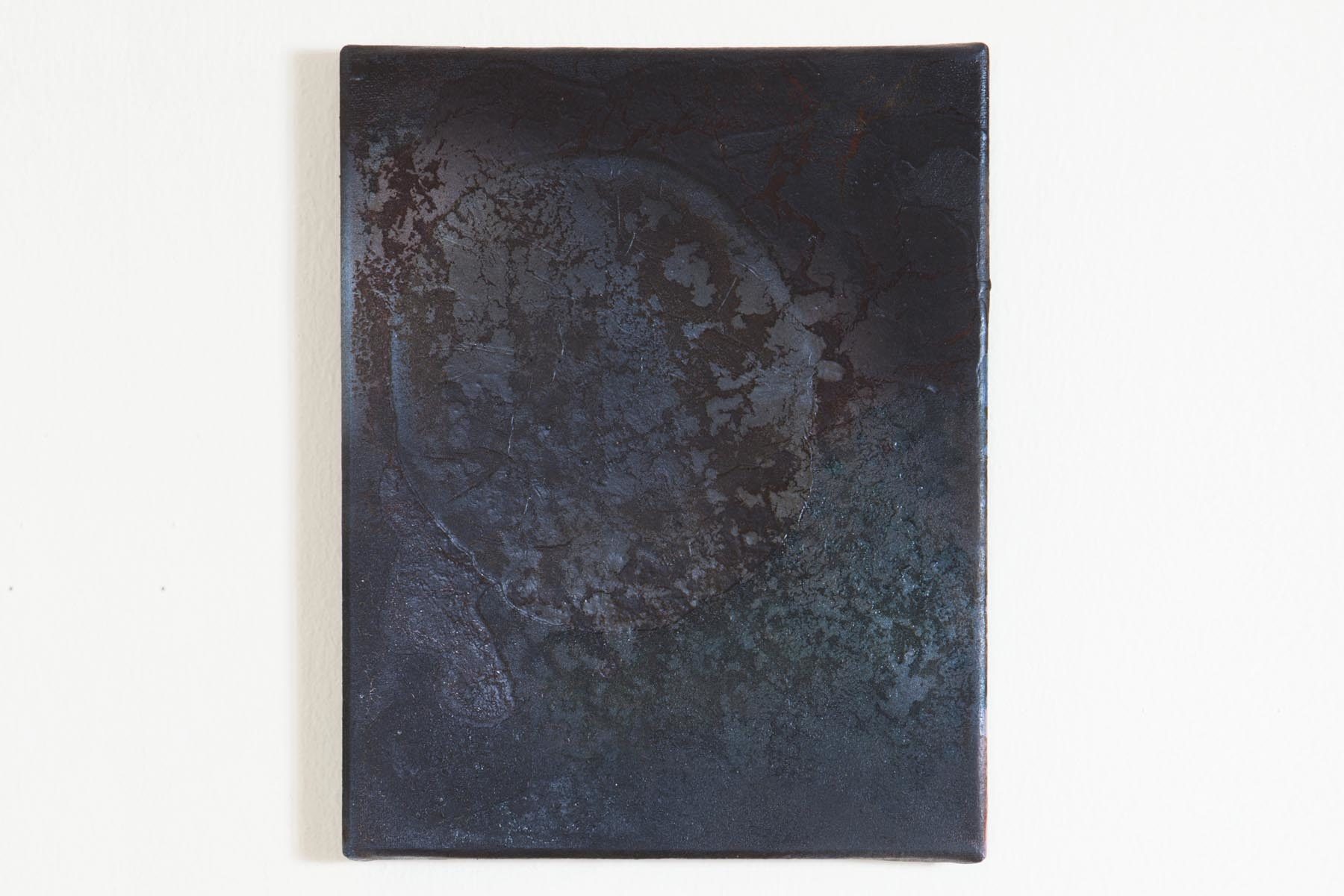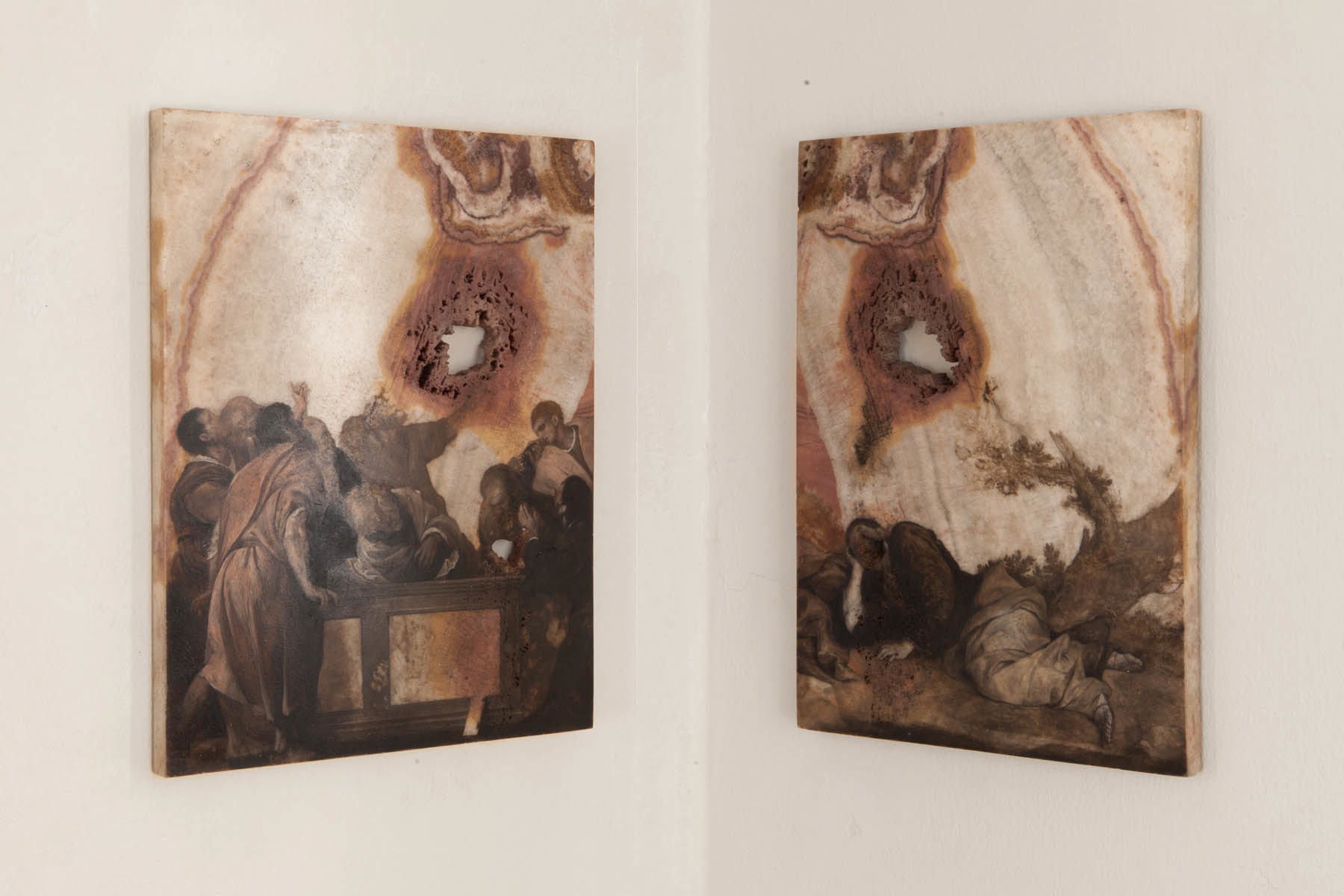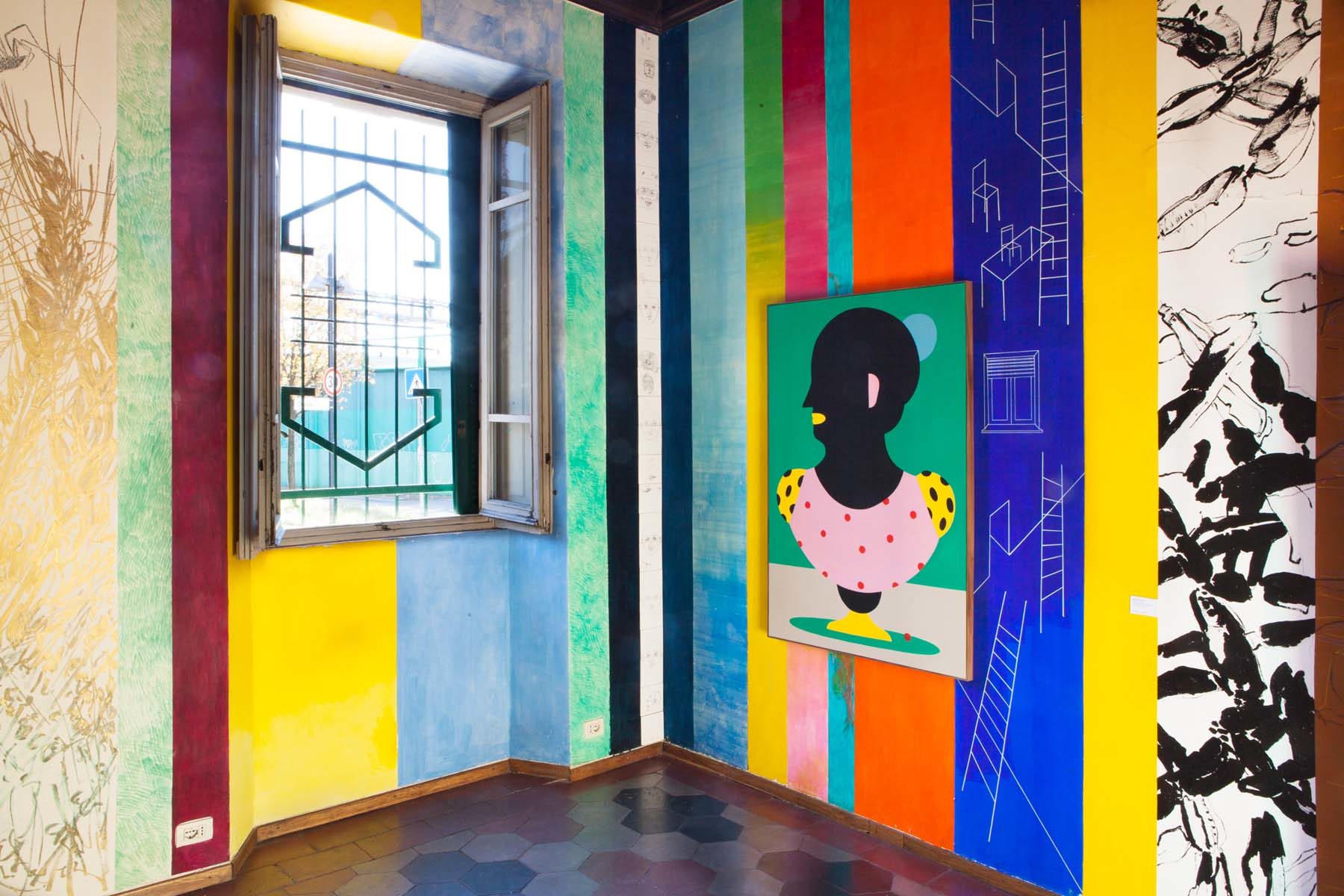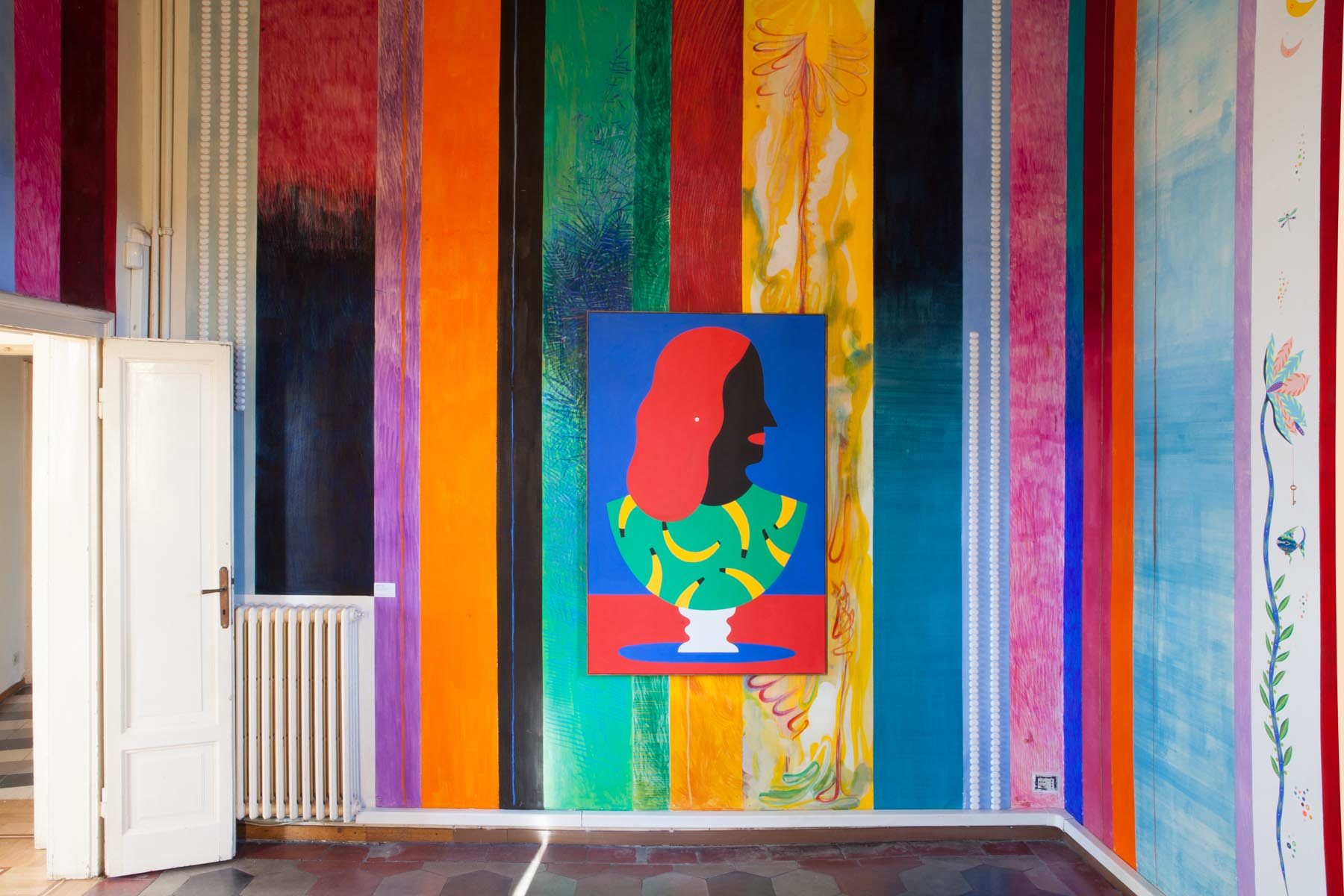Graffiare il presente
Paola Angelini, Mirko Baricchi, Paolo Bini, Lorenza Boisi, Thomas Braida, Alessandro Calabrese, Linda Carrara, Nebojša Despotović, Matteo Fato, Agostino Iacurci, Andrea Kvas, Francesca Longhini, Tiziano Martini, Isabella Nazzarri, Marco Pariani, Nazzarena Poli Maramotti, Alessandro Roma, Nicola Samorì, Alessandro Scarabello, Caterina Silva, Aleksander Velišček
Novate Milanese (I), Casa Testori
show, December 2018 ― January 2019
The showThe artists
Never stop fighting
Daniele Capra & Giuseppe Frangi
Graffiare il presente (i.e. “Scratching the Present”) is inspired by the conviction that there are works of art being made today for which the deepest source of inspiration is the desire to offer tools for interpretation of the reality that surrounds us, whether critical, poetic or militant; tools for holding this reality at bay, or for acting in it, in opposition to the reassuring but sterile idea of suggesting to the viewer a place that is set apart and sheltered from the contamination of the world. In response to this need to play an active role in our times, Graffiare il presente presents works produced in the year 2018 by twenty-one artists, all Italian and all born in the seventies and eighties. These are works that are intended to serve as bricks supporting our own and others’ weight, capable of fighting to escape slipping into the indistinct oblivion that so quickly swallows everything up. These works are offered to the viewer as tools for thought, theses and theorems – both visual and ideal – capable of supporting the suggestion of utopia, the ambition of signifying and the intention of withstanding the tensions and perils of the future: the most treacherous of times, ready to dissolve our ambitions like waves breaking on the shore.
The purposes of the exhibition include determining how the choice and practice of the medium of painting goes well beyond its alleged self-centredness and exclusive focus on linguistic-stylistic aspects or on an unproductive form of expressive intimism. The choice of painting is not a random one in a place that has, in its history, been the theatre of the adventure in collecting of Giovanni Testori, a passionate lover of painting.
The works of particular intensity appearing in Graffiare il presente aim to demonstrate how, for an entire generation of artists, the practice of painting is inspired by a need to pursue significant intellectual goals, as an aesthetic, existential or political mission. Eschewing in every way the assertive and reconciling repetition of one’s own identity, the reassuring and inconclusive practice of art as decoration or as concise commentary on the world, the exhibition represents an anarchic attempt to reveal the most significant attempts to resist and not dissolve in the rapid banality of contemporary life.
As curators of the project, we wish to underline the artists’ conviction and generosity in responding to our invitation, confirmed by the quality of the works, the frequently expressed desire to submit particularly large artworks for the exhibition, and the artists’ active participation in the process of conception and public discussion. This can only be a signal of the extent to which the medium of painting is experienced as an idiom abounding in as-yet unexpressed potential, the significance of which is frequently ignored in our country’s official exhibition halls. This perception is supported by the experimental, often bold, but always methodologically rigorous force characterising many of the works on exhibit. After all, experimentalism is also the practically obligatory result of the pronounced tendency toward questioning that characterises the artists featured in the exhibition, and their strongly felt interior need to make an impact on the present, with its intrinsically formless, liquid, impenetrable nature.
Lastly, Graffiare il presente confirms that it is meaningful to hold a group exhibition, provided it is based on specific criteria, such as an opportunity for face-to-face interaction with the works of other artists and an opportunity for unexpected contaminations.
This catalogue was created with the intention of documenting the exhibition held at Casa Testori in December 2018 and January 2019 through documentative photographs representing the situation of the artworks as they appeared in the exhibition. Unlike established curatorial practice, which tends to release critical interpretation ahead of the artists’ work, or at the same time as it, we have preferred to use an antihierarchic structure that privileges the use of personal information sheets and combines our analytic narration with the artist’s own personal reflection. And finally, it appears to us to be significant – and necessary – to allow the artists to speak for themselves, asking them to tell us about the intimate reasons for their painting as a living, direct, militant experience, as soldiers who never stop fighting.
Daniele Capra & Giuseppe Frangi
Graffiare il presente (i.e. “Scratching the Present”) is inspired by the conviction that there are works of art being made today for which the deepest source of inspiration is the desire to offer tools for interpretation of the reality that surrounds us, whether critical, poetic or militant; tools for holding this reality at bay, or for acting in it, in opposition to the reassuring but sterile idea of suggesting to the viewer a place that is set apart and sheltered from the contamination of the world. In response to this need to play an active role in our times, Graffiare il presente presents works produced in the year 2018 by twenty-one artists, all Italian and all born in the seventies and eighties. These are works that are intended to serve as bricks supporting our own and others’ weight, capable of fighting to escape slipping into the indistinct oblivion that so quickly swallows everything up. These works are offered to the viewer as tools for thought, theses and theorems – both visual and ideal – capable of supporting the suggestion of utopia, the ambition of signifying and the intention of withstanding the tensions and perils of the future: the most treacherous of times, ready to dissolve our ambitions like waves breaking on the shore.
The purposes of the exhibition include determining how the choice and practice of the medium of painting goes well beyond its alleged self-centredness and exclusive focus on linguistic-stylistic aspects or on an unproductive form of expressive intimism. The choice of painting is not a random one in a place that has, in its history, been the theatre of the adventure in collecting of Giovanni Testori, a passionate lover of painting.
The works of particular intensity appearing in Graffiare il presente aim to demonstrate how, for an entire generation of artists, the practice of painting is inspired by a need to pursue significant intellectual goals, as an aesthetic, existential or political mission. Eschewing in every way the assertive and reconciling repetition of one’s own identity, the reassuring and inconclusive practice of art as decoration or as concise commentary on the world, the exhibition represents an anarchic attempt to reveal the most significant attempts to resist and not dissolve in the rapid banality of contemporary life.
As curators of the project, we wish to underline the artists’ conviction and generosity in responding to our invitation, confirmed by the quality of the works, the frequently expressed desire to submit particularly large artworks for the exhibition, and the artists’ active participation in the process of conception and public discussion. This can only be a signal of the extent to which the medium of painting is experienced as an idiom abounding in as-yet unexpressed potential, the significance of which is frequently ignored in our country’s official exhibition halls. This perception is supported by the experimental, often bold, but always methodologically rigorous force characterising many of the works on exhibit. After all, experimentalism is also the practically obligatory result of the pronounced tendency toward questioning that characterises the artists featured in the exhibition, and their strongly felt interior need to make an impact on the present, with its intrinsically formless, liquid, impenetrable nature.
Lastly, Graffiare il presente confirms that it is meaningful to hold a group exhibition, provided it is based on specific criteria, such as an opportunity for face-to-face interaction with the works of other artists and an opportunity for unexpected contaminations.
This catalogue was created with the intention of documenting the exhibition held at Casa Testori in December 2018 and January 2019 through documentative photographs representing the situation of the artworks as they appeared in the exhibition. Unlike established curatorial practice, which tends to release critical interpretation ahead of the artists’ work, or at the same time as it, we have preferred to use an antihierarchic structure that privileges the use of personal information sheets and combines our analytic narration with the artist’s own personal reflection. And finally, it appears to us to be significant – and necessary – to allow the artists to speak for themselves, asking them to tell us about the intimate reasons for their painting as a living, direct, militant experience, as soldiers who never stop fighting.
The Artists
Daniele Capra & Giuseppe Frangi
Paola Angelini
The pictorial work of Paola Angelini is based on an intense investigation of the figure that is built up with an abundant use of colour; on a strong two-dimensional quality of the subjects, who are often isolated against perspectival planes or the background; and on a style that is versatile and in constant evolution. Indeed the artist appropriates various modes of execution according not only to the chosen subject, but also to the dictates of a continually changing personal view. This recurring effect of doubt makes her a painter of fluid and inexhaustible development.
Apart from the human figure her works often depict botanical elements, sometimes shown individually as flowers or single plants, or else, by extension, as trees and forest. Many paintings are characterised by the anarchic stratification of different figurative moments, as seen in Fuori luogo #3 (“Out of Place #3”), overlapping the main subject by a simple coordinate juxtaposition, thus establishing stronger relationships of a psychological nature. Angelini’s technique reveals a visceral approach to her subject and to pictorial devices; the latter, unusual and bemusing, seethe under the viewer’s gaze interrogating him in an unwonted and stinging way.
Here is how the artist has described beginning to paint a new work, one of the more complex phases of painting.
“It’s not easy setting oneself to paint. For me it’s the most trying phase. It isn’t simply a beginning and there’s nothing natural about it. It’s easy to repeat oneself, plus I feel constrained by trying to justify the visual pleasure received from the choice of certain colours, or from a feeling of deep emotion when looking at a face painted on canvas. It may turn out that I’ll be delighted, or I’ll repeat myself and have a sense of belonging to one humanity. That’s why it’s complex starting each time from scratch, because I perceive all of this and, most especially, the spiritual given strongly characterising these expressive choices.”
Mirko Baricchi
Over the years Mirko Baricchi’s painting has progressively evolved from figuration towards a freer practice, lacking iconic reference and characterised by a careful consideration of aspects of colour and form. Although some slightly hinted-at figurative elements remain, his attention is mainly focused on the very process of executing the artwork. Indeed a central feature of his painting is the physical work and generative modality employed to define the framework within which the artwork takes form; all of this occurs in a sort of performance which, in keeping with the chain of the artist’s actions, also assumes an explorative function. That is to say, for Baricchi the artwork is an attempt quite similar to the one practised by a pole-vaulter in training: there’s a (symbolic) wall to get over and he continues his attempts until that height is easily achievable.
The works in the Selva series originate from rapid repetitions of brush strokes as well as partial removals of colour – using fingers, brushes, or rags – before the paint dries: in this way the painting achieves its form via opposing pictorial gestures. The title refers to the universe of the woods, to the interweaving of signs, to the memory of those micro-landscapes that exist in the memory of both artist and viewer.
Baricchi has explained his work in these words. “I always have an idea of how a painting I’m beginning should be; recently it happens that the idea is related to something I see, like a physical landscape, but the results are often not the ones I had foreseen. Starting in the very early morning I work immersed in the hilly countryside, with light coming from the north. The process is unconscious, the technical aspect is reduced to rhythm and brushstroke, but I try to keep my distance from ideas that are too bright and often disappointing. When all is said and done, my work’s about the profundity of action as well as about natural light.”
Paolo Bini
A shutter has come down on reality. Between one slat and another this artwork of great technical complexity allows a glimpse of the flash of a lost view. The canvas by Paolo Bini is arranged vertically as if it were a true window but it really plays on the ambiguity that creates suspense in the viewer. What lies beyond it? And does the shutter made of black masking tape stretched across the canvas actually hide or allow a view to filter through? Bini’s painting usually presents itself openly in a brightness that has no hidden interspaces. The geometric scansion of superimposed lines sets off chromatic tensions that blind the gaze , producing an effect of luminous brilliancy on our retina. Instead, with Pathway of Eden, Bini takes into account this grid that traps and obscures the free extension of the painted traces. In this way the brilliancy is painfully prevented, even if what filters through lights an even more strongly desired light and amazement with respect to what has been covered up. As the artist explains, this complex and technically-sophisticated compositional process is determined by the wish to re-endow painting with a brand new and deeply contemporary visual energy. “In the defragmentation of my abstract images, the painted stripes overlap and compose the artwork. The modus operandi is fundamental because it’s not about painting on just one background but rather the ‘modules’ that become surface, in an ideal and contemporary low-relief. My artworks follow a mental process and through my artistic invetsiagtion of surfaces and colour, I’m seeking to compose an original image that has within itdelf the characteristic of showing the time we live in. So with an ancient medium (painting) I want to transmit an image that adheres to reality. In fact, in my abstract works, it’s easy to intuit the concpet of pixels, frames and scans of the image, thus obtaining an originality that reveals the origin.”
Lorenza Boisi
Lorenza Boisi’s paintings are characterised by the particular verve of her colour, vibrant brushstrokes and a tight visual rhythm that takes form through vivid colour combinations. The human figure, landscape and vegetation are her most common subjects, expressed through nervous drawing and synthetic painting characterised by use of unnatural colours distributed over the canvas in patches, sometimes in stains, often leaving glimpses of the surface below.
In Endymion Boisi reinterprets the story of Endymion. In Greek mythology, the goddess Diana, who was in love with Endymion, entreated Zeus to replace death of her beloved with eternal slumber in order to preserve the beauty of his youth forever. The artist represents Endymion in the landscape (following a tradition that originated in the Renaissance), but alone, with his back resting against a rock and his eyes half-closed in a dream-like atmosphere, reading John Keats’ poem about him. The painting contains both a reference to the mythological character and an obvious anachronism, which the viewer must put back together, or re-imagine as part of yet another story.
Boisi’s reflections on her artistic practice are incisive and poetic. “I aspire to achieve a painting that is self-contained due to its organic completeness, which expands beyond itself into an unspecified dimension. But I cannot and do not want to talk about my painting. I will no longer write captions for my works, however large or small: I want them to be free of the yoke of improper language. Let us say what we can, without attempting to describe what cannot be said. Let only the true painters paint; and let someone else talk and write about painting.”
Thomas Braida
Thomas Braida’s work centres around a hyperbolic imagination, an eclectic polystylism and an ironic touch, often apparent in his titles. His paintings are populated by people, animals and strange creatures, borderline personalities created by his imagination, often busy doing something that is hard to understand. Stately narrative episodes, borrowed from the iconography of the saints or from classical mythology, are juxtaposed with apparently trivial situations in scenes bordering on the nonsensical. The artist uses his titles as a support or burlesque counterpoint to his stories, explaining what is represented, defining the context in which the work was produced or, in many cases, briefly outline incidents in the artist’s life. Braida’s art constantly crosses paths with his personal affairs and sharing of spaces and existential requirements with a community of fellow artists and friends, such as Fondazione Malutta or Atelier F at the Fine Arts Academy in Venice, where he studied.
Voglia di mare depicts two girls with their backs turned to the viewer who have waves on their legs and buttocks, probably painted on in a form of body painting. The setting and the wooded landscape appear improbable, as does the mysterious animal – a ferret? or a cat without legs? – dropping down from above and contributing to the construction of a situation in which everything appears to be out of place. The progression of stories we now normally read, innocuous and apparently peripherical, cat lovers who watch white-nationalist-white videos on YouTube and then join a neo-Nazi Facebook group, there’s Hitler now next to your uncle’s skull evokes the atmosphere of a still life (despite the disturbing moustached man), but the extremely lengthy title suggests a more existential reflection on our contradictory ideological condition in the age of the social networks.
“The other day, somebody told me he had heard people say that painting is a vocation, and I agree,” says Braida. “All the things that happen to a painter are unimportant. And time will decide, for all of us.”
Alessandro Calabrese
Within the context of “Graffiare il presente”, including an artist who works with technical means such as scanners and photography is an exception to the rule, which finds its motivation in the strongly pictorial nature of Calabrese’s images. In his works the artist seems, rather than to seek painting, to flee towards an experimentation of future states of that same discipline. The Long Thing: Re-assembling Images is a work the artist presented at the Amsterdam Fair in 2018 and he explains it like this. “It’s a participatory project that reflects on the concept of authorship and on the challenge to renounce it in this period of extreme proliferation of images. Visitors to the fair, artist colleagues and various figures tied to the art world were invited to donate one or more photographs, before definitively eliminating them, from their personal smartphones. Later all the photos were printed before being put through a paper shredder, thereby creating a pile of paper that grew in size day by day for the whole duration of the art fair. From time to time scansions were made of this growing mound via the use of a horizontal scanner. Finally the results of these scans – disturbed during the reading phase by my intervention, consisting of simply moving the device – were printed and labelled as a group work: here the single photogram is no longer recognisable but it contributes to generating new images that are similar to, but always different from, each other.”
The result is a series of images that document a kind of psychic and emotional disturbance, proposed as a factor connecting the biographies of those who, by participating in and sharing the project, became an integral part of the artwork. These biographies are called upon to equally share a situation which becomes, via Calabrese’s visual polish, a mutual objective.
Linda Carrara
The very action of painting is the subject of Linda Carrara’s canvases, where she uses figuration as an instrument for questioning viewers about reality and their expectations of finding its traces in the artwork. By rethinking the pictorial process, her working aims to re-examine and re-negotiate the stereotypes consolidated within the dynamics of representation; contrary to what the viewer might imagine from his first impression, these are debatable axioms for Carrara. In an unorthodox way, her works describe small portions of reality, with which the surfaces often interact directly and in a way unmediated by pictorial gesture: it’s almost as if the paintings were conceptual casts able to document (represent?) the original element in a two-dimensional form.
This is the case of Frottage #1, made by laying the canvas on the floor and disposing paint on the surface until it saturated every gap between the threads in the fabric. In this way the interruptions between tiles became the unconscious subjects of the painting. The artist then elaborated them by painting, in a hyper-realistic way, two pieces of masking tape similar to the ones used in the process of realisation, to which these allude.
In very clear terms, Linda Carrara narrates her approach. “If I repeatedly scratch the paintbrush across the surface, what happens? What happens if I use lots of paint and then I take it all off? … I ‘rub’ until the materials scraped and the scraping itself have given their fullest expression. Is it possible to depict the material of painting and not its subject? I don’t want to overlap them. I don’t want to repeat myself. I don’t want to erase. I don’t want to cover up. I want everything, even my indecision, to be visible. A stone is the Stone and it becomes part of my vocabulary’s alphabet to be used whenever it’s useful. The result is only an excuse to give vent to the painterly and mental action. I paint painting.”
Nebojša Despotović
Originating from a figurative matrix, Nebojša Despotović’s artwork has evolved to progressively incorporate both the working gestures and the masking of the image into the canvas, as he explores the border between recognisable elements and their dissolution in the purely painterly event. His works feature concise drawing and the use of flat, dense paint, chosen prevalently in dark tones to promote an intense concentration of the gaze and reveal the deep psychological complexity of the subjects represented.
Zum blauen Stern is a portrait of the artist’s family (with his parents, his wife and two daughters) in which multiple primitivist impulses emerge and the human figure seems to dissolve into liquid form inside a domestic environment, abbreviated in two dimensions, with an uncertain perspective. Ever since he began his career, the human subject, in the form of portraits, has been one of his preferred ways of working. These aren’t, however, representations that attempt to render recognisable the physiognomy of visages or any formal analysis of context; rather they are more like rough samplings taken from among the unfathomable depths of the mind, among subtle blades of light and harsh, unconscious features.
Speaking about his work, Despotović explains his painting as follows. “When we paint, we artists should imagine that we’re holding not a paintbrush but a knife in our hand. Not to cut the canvas, of course, but rather to defend ourselves from definitions, classifications, and rules, all imposed by our own reasoning; to free ourselves from anxiety and the will to control; and to be aware that painting isn’t difficult and, for us, it’s natural. And at last, painting and the very experience of the artistic act are an absolute luxury that, for us, however, is a crude necessity.”
Matteo Fato
For this artist painting is a practice intrinsically implicated in the references tossed around by today’s current events. However, his conception of these events is like a karstification, whereby pieces of the past can come to the surface and reveal their strong ties to the present. Matteo Fato works on deep levels, as can be seen in the work created especially for Graffiare il presente. The protagonist of his painting is a mysterious, yet iconic, figure of twentieth century Italian history: the physicist Ettore Majorana, who mysteriously disappeared without a trace in 1938. Fato’s approach to depicting the science genius has been mediated by his reading of a recent book by Giorgio Agamben. The philosopher posits Majorana had come to intuit that, in quantum physics, reality must dissolve into probability. Therefore, by disappearing, he himself entered in the very probabilistic field hypothesised by contemporary physics. By working on the figure, and more specifically the visage, of Majorana, it’s as if Fato is asking painting itself the fundamental question of what reality is. The question remains unanswered but the virtual nature of the piece expands and obfuscates the borders even more. In this humble and passionate way painting picks up the thread of discourse, as seen even in the brush’s painterly gesture on the small canvas that completes the diptych. Matteo Fato explains his motivations for choosing an age-old genre like portraiture. “I believe that portraiture is still today (as in the past) an important means of observing the landscape of our time; painting has been, is still today and will always be an important reflection on our contemporary period. Speaking of painting’s language, I think the most important thing to always ask oneself is: am I using painting because I have no other choice? So, just like any other language, I think painting should be used when no other ‘words’ will do to express the idea. The matter raised by Deleuze, in Cinema 1: The Movement-Image and Cinema 2: The Time-Image, comes to mind. In speaking about the image’s movement, Deleuze conceives it as a regulated passage from one form to another, that’s to say an order of poses or of privileged instant states; and he tells us the revolution of the modern age lay in taking that movement not towards privileged instances but towards any instances of any kind.
I’ve always loved his definition when I think about painting as a “privileged instance.” Painting and drawing: their power comes from this possibility of self-definition as privileged moments that emphasise, more than anything else, an undistinguished condition and mutation of reality in our time.”
Agostino Iacurci
Agostino Iacurci is known for his big, fascinating public wall paintings in cities all over the world. His is a unique visual repertoire, made imposing by his synthesis of form and use of bright colours. In parallel with his work as a street artist, Iacurci has always continued to work in the studio, producing artworks characterised by the same stylistic cleanliness and populated by the same images as his public wall paintings. Iacurci’s style is governed by an expressive sincerity that puts everything on the surface. Sometimes the content seems to be secondary in importance to the decorative nature of his lines and compositions. The process of simplification he uses each time incorporates an alienating factor triggering discord and suggesting visions of the world. As in these two Busts, in which the classic, celebratory profile ironically proposed is unexpectedly asked to deal with the element of black skin; a light touch opening up a door to one of the great themes of our times. In any case, colour is the key to Iacurci’s painting, as he himself confirms: “My interest in colour originated after seeing the exhibition El color de los Dioses. Policromía en la Antigüedad clásica y de Mesoamérica in Mexico City. The exhibition presented reproductions of ancient Greek and Roman statues coloured with their original colours and decorations, alongside Mesoamerican sculptures and architecture, also coloured using the same technique. This is how I became more seriously interested in the use of colour in the ancient world and in how, despite the scientific evidence to the contrary, in our collective imagination we still think of the classical world in the West as white, and heroic, with all the political and social consequences this has had.”
Andrea Kvas
Andrea Kvas’s work aims to free painting from the constriction of two dimensions and his emotional demands, making his work a baffling ongoing challenge in extension of its field of application to all possible surfaces and substrates. The artist sees painting as a processual action that alters the nature of that which is visible, starting with its colour, gloss and consistency, and, in the final instance, reveals a desire to change the epidermis of the elements and objects making up reality. Whether it should take the shape of a curtain, of wood, or of a piece of brick or canvas, Kvas sees painting as the space of possibility, an intellectual game in which things attempt to be something other than what they seem, and, above all, a possible metamorphosis.
The Untitled works in the exhibition, which the artist has painted and repainted in an methodical/maniacal way over the course of several years (his works are often not finished until they actually leave his studio), are made by combining layers of different materials and have a surface that may be tarnished by organic phenomena and chemical agents. They challenge us to go beyond frontal observation of the image, to abandon the spectator’s static position and observe the work of art from different points of view, in its simple, purest visible essence.
“I’m interested in objects, from enamels to Zsolnay’s eosin and the plumage of the satyr tragopan, in which colour and the material that make up the object become almost magical elements,” says Kvas. “I am prone to the fascination of surfaces that behave in what I see as unexpected ways. In my works I attempt to achieve results similar to those I see, using unorthodox procedures to create materials that I then cause to react on the substrate. What I aim to obtain is an uneven, unforeseeable mixture that has a life of its own, to the extent that the material itself becomes the subject of my fascination.”
Francesca Longhini
Francesca Longhini’s artistic practice draws on the great sensitivity to materials and their physical and symbolic properties the artist has developed working in sculpture. Her two-dimensional artworks apply a geometric, minimalist approach incorporating references to twentieth-century avant-garde movements, particular the abstract and Suprematist styles, with the lyrical lightness of line characteristic of the work of artists such as Fausto Melotti and Alexander Calder. The artist frequently uses untreated canvas, on which she paints two-dimensional shapes in flat colours, such as squares and rectangles, or lays a foil of precious materials. These polygons are then related to one another by an orderly, rational system of lines, as if they were flow diagrams forming an open system of relationships.
Her latest works, such as The sleeper who wants to be awakened is dreaming lions, are however characterised by great freedom of composition and use of complex shapes, alternating sinuous curves with areas defined by broken lines. Simple colours are flanked by use of gold, silver and copper leaf and marbled colour, as if the surface of the painting were a constantly changing inlay.
Longhini describes her work as a non-stop race. “I see painting as a long trip, a marathon in which we hand over the baton. Every once in a while, an athlete changes the direction and runs back over the ground others have already travelled, but it cannot be wrong to go back over paths already travelled if you do it in your own way. Also because runners run in an oval shape, whichever way they are going.”
The artist goes on to explain why she doesn’t like to guide the way people interpret her work. “What truly interests me is that the spectator should be exactly what the word suggests: a person who spends time looking. I believe my paintings are only revealed if you dedicate enough time to them.”
Tiziano Martini
Tiziano Martini’s work is based on a processual pictorial practice in which the execution of the work plays a fundamental role. The artist acts on the surface of the work, detaching the partially dry paint he has distributed over the canvas using a single medium, with a tearing action (partly random and partly controlled) that breaks up and tears the outermost layer of colour. This gesture is reiterated over and over to obtain the desired composition, in which the painting no longer needs anything and is complete, in that any further action would result in a loss of visual energy, lowering its status. This process leads to creation of textures and lumps of paint characterised by low relief of a highly sculptural and material character, encouraging the onlooker to observe the work from different points of view in an attempt to compose a unified vision.
Il Brian Eno del black metal uses colour on a limited portion of canvas, leaving most of the linen bare and allowing us to imagine, on the basis of little stains and dirt, some of the steps involved in the artist’s production of the work in his studio.
Martini describes his practice as follows: “I get most of my inspiration outside the studio, at times when I am physically distant from my work: I almost always need a lot of encouragement to perceive my emotional involvement. I go into the studio because I feel a sort of responsibility. I always have to force myself and struggle to overcome the initial resistance that I seem to create myself, due to my own character. The most enjoyable part, the part that flows most easily, is the manual and practical work I perform in response to unexpected developments. For years and years, I uselessly store leftover and waste materials for which I fail to find a form.”
Isabella Nazzarri
Against the chip-ped and cracked background prepared for the acrylic-painted canvas, fluid elements are unleashed in a fugue (as suggested by the title The Elements Chase Each Other); in so doing they seem to belong to another realm rich in such oppositions as hardness versus liquidity, old versus new. In Nazzarri’s canvas – albeit marked by that lyric warmth that distinguishes her artworks, be they paintings or installations – a silent struggle is taking place. It lies exactly in the new seeking a free space in which to emerge and found another possible order that doesn’t reject movement. Isabella Nazzarri is an artist who reveals, behind the light quality of so many of her images, a coherent line of thoughts; these especially concern matter, which is explored and tested by affecting, time and again, unexpected metamorphoses and short-circuits. Her experience is played constantly between the polarities of rigour and freedom; of compilation and new visions that alwsys provoke sudden accelerations. This is the root of the poetic tension characterising her images as they succeed in uniting the dimensions of balance and movement which are essential for her.
Isabella Nazzarri describes her artwork as follows. “The Elements Chase Each Other is a large canvas of all purple (the colour of metamorphosis) in which planes of various imagined materials and elements dance, overlap and fluctuate in space. In many ways this work recalls a musical composition: colour provides timbre while signs serve like accent marks. Here there’s no representation but rather the appearance of evocations able to ask open questions. I like the fact that painting can be a training ground for self-awareness and bring viewers to a moment of greater consciousness. I do the same when I paint; I never have a premeditated idea of what will happen, but rather I try to surprise myself every day.”
Marco Pariani
The long shadow of Abstract Expressionism is still cast today over a new generation of artists, who have turned to American painting to recover its aggressive energy that’s able to scar and blow up any visual status quo. Marco Pariani is an exponent of this group so it’s no chance that he left his native Busto Arstizio a few years ago to move to Brooklyn, where he still has his studio today. His painting is built up through layers applied in highly disciplined and sophisticated processes, where there is also space for the random behaviour of paint poured onto the canvas. The push of a gestural painting style must always take into account that defined and compressed space in the area left free of paint toward the margins of the canvas. In spite of the absence of subjects in Pariani’s work, his titles underscore a polemical, ironical – and sometimes even angry – antagonism toward the very many fashions imposed on life today. An example is seen here in the canvas titled Perfect Body. There’s no very clear, literal correspondence between the title and the painting but its destabilising tension evokes a greater ambition and a possible freedom. Marco Pariani confirms this aspect in speaking about his relationship to painterly action. “I decided to exhibit a piece that’s part of a series of artworks I developed in 2018, but it’s the first one – in a long time – in which I used oil paints; it’s also the first of a new series where the painting has new textures and backgrounds. Painting is an integral part of my days, it’s become a need I live with and it keeps my thoughts and hands busy. It’s a true delight for me to give free expression to my concept of painting and, as long as that holds true, I won’t bother with rules and dimensions. Having found an escape route from everything I don’t like, I try to have as much fun as possible.”
Nazzarena Poli Maramotti
Nazzarena Poli Maramotti’s painting is a fluid, sensual, visceral exploration of the boundary between figuration and pictorial gesture, the respective strengths of which pursue one another over the canvas, putting the spectator in a condition of uncertainty and suspension of judgement. The artist breaks her subject down into big, synthetic brushstrokes and fields of colour, subtracting details and elements that lead too directly to reality. Thus Poli Maramotti lets the painting itself do the talking, silencing the invasive world and solving the question of mimesis freely and openly, with a multitude of different meanings, so that trees and bushes break out into fields of colour, while a rose becomes a homogeneous stain of colour that renders it unrecognisable, pure paint.
Roma (“Rome”) is a landscape characterised by the presence of water, almost like a cut-out from a wider-ranging view of natural elements, developed with a symmetrical construction and a limited colour palette. Vegetation is represented concisely, and the reflections on the surface of the water are airy, carried by the waves, as if in a faded memory we can’t quite recall.
The artist explains her practice in relation to thinking and time. “I consider painting, and art in general, a discipline in its own right. The creative process advances like a living being, so that stopping too long in one place means losing your impetus and authenticity. This is what happens when you think too much before you start painting. Only by taking a closer look at my work after the fact can I manage to identify and focus on my goals, on what I am looking for.
The physical action of making often already knows and anticipates the schemes of the brain, which follows it, collecting and reordering my thoughts and attempting to translate them into words.”
Alessandro Roma
There is one word that captures Alessandro Roma’s painting better than any other and that word is vertigo. Roma began with an investigation that, over the years, has led him to more clearly define a perception of the world freed from gravity, from the intrinsic weight of things. As he gradually conquered lightness, he began to experiment with new supports, freeing the artwork from the canvas’s rigidity; an example is seen in Forms in transition, the Casa Testori piece included in his solo show at the MIC in Faenza. It’s up to air to determine the forms and to move the drawn line across the canvas, just like when the wind blows leaves. In this development Roma also communicates a sense of impermanence without altering the serene nature of his painting; he uses bleach to remove paints on part of the worked canvas, thereby leaving an almost shroud-like blur. It’s a piece that dialogues discretely with the present: it proposes itself as a curtain to protect the viewer’s gaze from the ruins.
Here’s how Alessandro Roma explains his choice to work by removing paint.
“I began by working on cotton fabrics because I was looking for a quality of lightness in the supports I used for painting. I made a number of trials, and I continue to do so, on fabrics, until I came across the simple bleaching technique applied to a surface of painted cotton. I dip my brush in a liquid that doesn’t apply paint but actually removes it. However, to my eye it’s not just that; it doesn’t give me any impression of working with wood-block technique, whereby I have to subtract material to obtain the sign I want. In my case it was more like touching the support very lightly and giving the sign time to appear. It’s precisely this apparition time that’s most attractive to me. I have limited control over the drawing or – it would be more exact to say – the drawing is not immediately evident. That means that, each and every time, I’m unable to decipher what I’m drawing. Lightness, waiting, surprise, and pure signs are the characteristics that fascinate me and push me to use this technique.”
Nicola Samorì
For Nicola Samorì painting is a sophisticated ritual of recovering and deconstructing images of the past. The meaning of this operational method is always to bring to the surface that living chord of feeling that had been anaesthetised by time. Here Samorì exhibits two works carried out on onyx stone, a material that recalls precious objects created in the past. The images painted on this stone are taken from the Verona Cathedral Assumption by Titian and the Prado’s Dream of Jacob by Ribera. Samorì incorporates the onyx’s defects into the composition, giving them a strategic function. In the Assumption the hole coincides with the space where the figure of Mary should appear. The hole is a small void swallowing up the heart of the artwork, thus an image usually perceived in a taken-for-granted way is charged with new tension and worry. Therefore, painting has re-discovered its destabilising vocation: while reflecting on its own transitory nature, it proposes to be a valuable and trustworthy interlocutor for the wounded gazes of our time. The use of a mineral support like onyx is part of a strategy conceived right down to even the finest detail, as becomes clear in the artist’s words. “As the support for the two Specula paintings I chose onyx stone, cut from the left-over portion of a block I had used to make three sculptures between 2013 and 2015. Thus, the waste stone becomes a place of miracles, where apparition and dream coincide with something that has never seen the light of day: the stone’s heart, filled with crystals. In fact these are the geodes which – when sliced in sections – become cut-outs holes in the plates covered with oil paint as well as places of implosion for the image or the mineral scars framing the figures. In the Assumption, she who is pure becomes the macula, the stone’s defect, an episode that catalyses the crowd’s attention. In the Dream of Jacob, a mineral crack opens into the sleeper’s face liking a seeming spy-hole through which to watch the revolutions of his unconscious. Painting on stone forces the image to assume a fossil stability as well as a high risk of fractures and the paradox of porcelain: unalterable and extremely fragile.”
Alessandro Scarabello
Alessandro Scarabello’s work represents the multi-faceted evolution of a number of figurative stimuli which have been progressively diluted over the years in favour of a more surreal sensibility and an approach that is sometimes gestural, incorporating meta-pictorial instances. The artist frequently constructs his images by masking or subtracting visual elements: The human presence is a recurrent element in his canvases, barely outlined in a synthetic form of painting, in scenes constructed in such a way that its absence is psychologically apparent. Scarabello works by removing certain details that play a fundamental role in description or narration, giving the scene a feeling of suspension and emotional tension.
The works in the Phoenix series depict undecipherable situations, such as a set table awaiting the diners, a bit of floor on which we can make out the shadow of an unidentifiable object, a mysterious figure hiding behind a polygon. There is no rational logical connection between the visual elements, and it is up to the observer to attempt to unravel and recompose the enigma – if possible!
Scarabello sees painting as an intimate practice of alienation, which he describes as follows: “Painting allows me to escape the incessant flow of human action, so that I can see it flowing before me. I consider it a privilege to create painted images in a world saturated with digital images. I’m aware I am taking what may be considered a radical position, but this is the only way I can manage to fix and reveal my deepest nature and preserve my independence as an individual. Mine is an ongoing attempt to interpret events, and not only personal ones, through the infinite possibilities painting offers me.”
Caterina Silva
“My work always starts with a destruction” Caterina Silva has commented about her art. Her investigation tends towards a painting that still preserves performative value. Thus, her choice of an unstable support becomes a prolongation of the gesture that brought the artwork into being: the forms are unsettled inside an image that doesn’t achieve arrangement. Silva’s painting tends to originate on the canvas via a process of emersion, that develops out of itself and is stimulated by the artist’s strong visions. Self-Portrait of a Landscape 3 suggests an idea of objective loyalty to a context called upon to be a self-representation. It’s a work of taking soundings underground, allowing the reality existing beneath reality – with its burden of uncertainty and distress – to surface on the picture plane.
Silva explains the genesis of her work. “Self-Portrait of a Landscape was carried out between January and February 2018 in a studio overlooking a fjord in the Norwegian mountains. The liquid paint was left outdoors to freeze in small blocks and then, in the warmth of the studio, it was allowed to melt on the canvas. The sequence generated in this way corresponds to the routine to which I subject my body everyday (starting at dawn, before the sun lights the valley for barely three hours). The resulting painting is then left outdoors, under the snow, for several nights. The landscape surrounding the painting changes constantly, the clouds race overhead, grey is the predominant colour that comes to mind and characterises the canvas. I exert as little power as possible over the image that wants to come to the surface. I try to line up the exterior space with the interior one, all on the same plane in keeping with a transitive and constant motion in which my breath guides every single movement. The subjective ‘I’ never completely disappears but is certainly often absent.”
Aleksander Velišček
Velišček’s painting has no dearth of sincerity. His is a declarative art that derives its energy from exposing itself to the world and from promoting gazes that impede the dominant way of thinking. Its strength and its charm lie precisely in this explicit character that lead each artwork to be direct, whether expressing love or dislike. By his very nature the artist always tends to scratch the present time or to engage it by employing the truth about personalities who are now out of fashion. In this particular piece Velišček worked on Donald Trump, one of the figures that is making a strong mark on our time. The artist has captured the American President’s most identifiable somatic trait, the one element that pins him down: his hair style. This detail, replicated in its arrogant improbability, takes on a power that is no longer a symbol but rather a dead-weight that drags heavily on the time in which we’re living. In Velišček’s work there’s an irony in the work’s quite cartoon-like reiteration as well as an almost painful and poetic awareness of a destiny we would have preferred to be different.
Aleksander Velišček has explained his choice to work on a multiplicity of elements in these terms. “By simultaneously setting up this year’s various thematic threads, my painting continues to consolidate even more its perspectival decentralisation. The decentralised or peripheral perspective allows me to achieve a clearer legibility of the facts while our gazes’ constant lateral shifts help renew those analytical tools best suited for reading our present time. Therefore, the act of being in the world is captured inside the coordinates of knowledge. There’s opening onto the world and onto that set of strong relationships created between two points; these are articulated through discourse, which must be conceived as a multiplicity of elements sometimes appearing, or even being, in contradiction but tending nonetheless to develop the same strategy.”
Daniele Capra & Giuseppe Frangi
Paola Angelini
The pictorial work of Paola Angelini is based on an intense investigation of the figure that is built up with an abundant use of colour; on a strong two-dimensional quality of the subjects, who are often isolated against perspectival planes or the background; and on a style that is versatile and in constant evolution. Indeed the artist appropriates various modes of execution according not only to the chosen subject, but also to the dictates of a continually changing personal view. This recurring effect of doubt makes her a painter of fluid and inexhaustible development.
Apart from the human figure her works often depict botanical elements, sometimes shown individually as flowers or single plants, or else, by extension, as trees and forest. Many paintings are characterised by the anarchic stratification of different figurative moments, as seen in Fuori luogo #3 (“Out of Place #3”), overlapping the main subject by a simple coordinate juxtaposition, thus establishing stronger relationships of a psychological nature. Angelini’s technique reveals a visceral approach to her subject and to pictorial devices; the latter, unusual and bemusing, seethe under the viewer’s gaze interrogating him in an unwonted and stinging way.
Here is how the artist has described beginning to paint a new work, one of the more complex phases of painting.
“It’s not easy setting oneself to paint. For me it’s the most trying phase. It isn’t simply a beginning and there’s nothing natural about it. It’s easy to repeat oneself, plus I feel constrained by trying to justify the visual pleasure received from the choice of certain colours, or from a feeling of deep emotion when looking at a face painted on canvas. It may turn out that I’ll be delighted, or I’ll repeat myself and have a sense of belonging to one humanity. That’s why it’s complex starting each time from scratch, because I perceive all of this and, most especially, the spiritual given strongly characterising these expressive choices.”
Mirko Baricchi
Over the years Mirko Baricchi’s painting has progressively evolved from figuration towards a freer practice, lacking iconic reference and characterised by a careful consideration of aspects of colour and form. Although some slightly hinted-at figurative elements remain, his attention is mainly focused on the very process of executing the artwork. Indeed a central feature of his painting is the physical work and generative modality employed to define the framework within which the artwork takes form; all of this occurs in a sort of performance which, in keeping with the chain of the artist’s actions, also assumes an explorative function. That is to say, for Baricchi the artwork is an attempt quite similar to the one practised by a pole-vaulter in training: there’s a (symbolic) wall to get over and he continues his attempts until that height is easily achievable.
The works in the Selva series originate from rapid repetitions of brush strokes as well as partial removals of colour – using fingers, brushes, or rags – before the paint dries: in this way the painting achieves its form via opposing pictorial gestures. The title refers to the universe of the woods, to the interweaving of signs, to the memory of those micro-landscapes that exist in the memory of both artist and viewer.
Baricchi has explained his work in these words. “I always have an idea of how a painting I’m beginning should be; recently it happens that the idea is related to something I see, like a physical landscape, but the results are often not the ones I had foreseen. Starting in the very early morning I work immersed in the hilly countryside, with light coming from the north. The process is unconscious, the technical aspect is reduced to rhythm and brushstroke, but I try to keep my distance from ideas that are too bright and often disappointing. When all is said and done, my work’s about the profundity of action as well as about natural light.”
Paolo Bini
A shutter has come down on reality. Between one slat and another this artwork of great technical complexity allows a glimpse of the flash of a lost view. The canvas by Paolo Bini is arranged vertically as if it were a true window but it really plays on the ambiguity that creates suspense in the viewer. What lies beyond it? And does the shutter made of black masking tape stretched across the canvas actually hide or allow a view to filter through? Bini’s painting usually presents itself openly in a brightness that has no hidden interspaces. The geometric scansion of superimposed lines sets off chromatic tensions that blind the gaze , producing an effect of luminous brilliancy on our retina. Instead, with Pathway of Eden, Bini takes into account this grid that traps and obscures the free extension of the painted traces. In this way the brilliancy is painfully prevented, even if what filters through lights an even more strongly desired light and amazement with respect to what has been covered up. As the artist explains, this complex and technically-sophisticated compositional process is determined by the wish to re-endow painting with a brand new and deeply contemporary visual energy. “In the defragmentation of my abstract images, the painted stripes overlap and compose the artwork. The modus operandi is fundamental because it’s not about painting on just one background but rather the ‘modules’ that become surface, in an ideal and contemporary low-relief. My artworks follow a mental process and through my artistic invetsiagtion of surfaces and colour, I’m seeking to compose an original image that has within itdelf the characteristic of showing the time we live in. So with an ancient medium (painting) I want to transmit an image that adheres to reality. In fact, in my abstract works, it’s easy to intuit the concpet of pixels, frames and scans of the image, thus obtaining an originality that reveals the origin.”
Lorenza Boisi
Lorenza Boisi’s paintings are characterised by the particular verve of her colour, vibrant brushstrokes and a tight visual rhythm that takes form through vivid colour combinations. The human figure, landscape and vegetation are her most common subjects, expressed through nervous drawing and synthetic painting characterised by use of unnatural colours distributed over the canvas in patches, sometimes in stains, often leaving glimpses of the surface below.
In Endymion Boisi reinterprets the story of Endymion. In Greek mythology, the goddess Diana, who was in love with Endymion, entreated Zeus to replace death of her beloved with eternal slumber in order to preserve the beauty of his youth forever. The artist represents Endymion in the landscape (following a tradition that originated in the Renaissance), but alone, with his back resting against a rock and his eyes half-closed in a dream-like atmosphere, reading John Keats’ poem about him. The painting contains both a reference to the mythological character and an obvious anachronism, which the viewer must put back together, or re-imagine as part of yet another story.
Boisi’s reflections on her artistic practice are incisive and poetic. “I aspire to achieve a painting that is self-contained due to its organic completeness, which expands beyond itself into an unspecified dimension. But I cannot and do not want to talk about my painting. I will no longer write captions for my works, however large or small: I want them to be free of the yoke of improper language. Let us say what we can, without attempting to describe what cannot be said. Let only the true painters paint; and let someone else talk and write about painting.”
Thomas Braida
Thomas Braida’s work centres around a hyperbolic imagination, an eclectic polystylism and an ironic touch, often apparent in his titles. His paintings are populated by people, animals and strange creatures, borderline personalities created by his imagination, often busy doing something that is hard to understand. Stately narrative episodes, borrowed from the iconography of the saints or from classical mythology, are juxtaposed with apparently trivial situations in scenes bordering on the nonsensical. The artist uses his titles as a support or burlesque counterpoint to his stories, explaining what is represented, defining the context in which the work was produced or, in many cases, briefly outline incidents in the artist’s life. Braida’s art constantly crosses paths with his personal affairs and sharing of spaces and existential requirements with a community of fellow artists and friends, such as Fondazione Malutta or Atelier F at the Fine Arts Academy in Venice, where he studied.
Voglia di mare depicts two girls with their backs turned to the viewer who have waves on their legs and buttocks, probably painted on in a form of body painting. The setting and the wooded landscape appear improbable, as does the mysterious animal – a ferret? or a cat without legs? – dropping down from above and contributing to the construction of a situation in which everything appears to be out of place. The progression of stories we now normally read, innocuous and apparently peripherical, cat lovers who watch white-nationalist-white videos on YouTube and then join a neo-Nazi Facebook group, there’s Hitler now next to your uncle’s skull evokes the atmosphere of a still life (despite the disturbing moustached man), but the extremely lengthy title suggests a more existential reflection on our contradictory ideological condition in the age of the social networks.
“The other day, somebody told me he had heard people say that painting is a vocation, and I agree,” says Braida. “All the things that happen to a painter are unimportant. And time will decide, for all of us.”
Alessandro Calabrese
Within the context of “Graffiare il presente”, including an artist who works with technical means such as scanners and photography is an exception to the rule, which finds its motivation in the strongly pictorial nature of Calabrese’s images. In his works the artist seems, rather than to seek painting, to flee towards an experimentation of future states of that same discipline. The Long Thing: Re-assembling Images is a work the artist presented at the Amsterdam Fair in 2018 and he explains it like this. “It’s a participatory project that reflects on the concept of authorship and on the challenge to renounce it in this period of extreme proliferation of images. Visitors to the fair, artist colleagues and various figures tied to the art world were invited to donate one or more photographs, before definitively eliminating them, from their personal smartphones. Later all the photos were printed before being put through a paper shredder, thereby creating a pile of paper that grew in size day by day for the whole duration of the art fair. From time to time scansions were made of this growing mound via the use of a horizontal scanner. Finally the results of these scans – disturbed during the reading phase by my intervention, consisting of simply moving the device – were printed and labelled as a group work: here the single photogram is no longer recognisable but it contributes to generating new images that are similar to, but always different from, each other.”
The result is a series of images that document a kind of psychic and emotional disturbance, proposed as a factor connecting the biographies of those who, by participating in and sharing the project, became an integral part of the artwork. These biographies are called upon to equally share a situation which becomes, via Calabrese’s visual polish, a mutual objective.
Linda Carrara
The very action of painting is the subject of Linda Carrara’s canvases, where she uses figuration as an instrument for questioning viewers about reality and their expectations of finding its traces in the artwork. By rethinking the pictorial process, her working aims to re-examine and re-negotiate the stereotypes consolidated within the dynamics of representation; contrary to what the viewer might imagine from his first impression, these are debatable axioms for Carrara. In an unorthodox way, her works describe small portions of reality, with which the surfaces often interact directly and in a way unmediated by pictorial gesture: it’s almost as if the paintings were conceptual casts able to document (represent?) the original element in a two-dimensional form.
This is the case of Frottage #1, made by laying the canvas on the floor and disposing paint on the surface until it saturated every gap between the threads in the fabric. In this way the interruptions between tiles became the unconscious subjects of the painting. The artist then elaborated them by painting, in a hyper-realistic way, two pieces of masking tape similar to the ones used in the process of realisation, to which these allude.
In very clear terms, Linda Carrara narrates her approach. “If I repeatedly scratch the paintbrush across the surface, what happens? What happens if I use lots of paint and then I take it all off? … I ‘rub’ until the materials scraped and the scraping itself have given their fullest expression. Is it possible to depict the material of painting and not its subject? I don’t want to overlap them. I don’t want to repeat myself. I don’t want to erase. I don’t want to cover up. I want everything, even my indecision, to be visible. A stone is the Stone and it becomes part of my vocabulary’s alphabet to be used whenever it’s useful. The result is only an excuse to give vent to the painterly and mental action. I paint painting.”
Nebojša Despotović
Originating from a figurative matrix, Nebojša Despotović’s artwork has evolved to progressively incorporate both the working gestures and the masking of the image into the canvas, as he explores the border between recognisable elements and their dissolution in the purely painterly event. His works feature concise drawing and the use of flat, dense paint, chosen prevalently in dark tones to promote an intense concentration of the gaze and reveal the deep psychological complexity of the subjects represented.
Zum blauen Stern is a portrait of the artist’s family (with his parents, his wife and two daughters) in which multiple primitivist impulses emerge and the human figure seems to dissolve into liquid form inside a domestic environment, abbreviated in two dimensions, with an uncertain perspective. Ever since he began his career, the human subject, in the form of portraits, has been one of his preferred ways of working. These aren’t, however, representations that attempt to render recognisable the physiognomy of visages or any formal analysis of context; rather they are more like rough samplings taken from among the unfathomable depths of the mind, among subtle blades of light and harsh, unconscious features.
Speaking about his work, Despotović explains his painting as follows. “When we paint, we artists should imagine that we’re holding not a paintbrush but a knife in our hand. Not to cut the canvas, of course, but rather to defend ourselves from definitions, classifications, and rules, all imposed by our own reasoning; to free ourselves from anxiety and the will to control; and to be aware that painting isn’t difficult and, for us, it’s natural. And at last, painting and the very experience of the artistic act are an absolute luxury that, for us, however, is a crude necessity.”
Matteo Fato
For this artist painting is a practice intrinsically implicated in the references tossed around by today’s current events. However, his conception of these events is like a karstification, whereby pieces of the past can come to the surface and reveal their strong ties to the present. Matteo Fato works on deep levels, as can be seen in the work created especially for Graffiare il presente. The protagonist of his painting is a mysterious, yet iconic, figure of twentieth century Italian history: the physicist Ettore Majorana, who mysteriously disappeared without a trace in 1938. Fato’s approach to depicting the science genius has been mediated by his reading of a recent book by Giorgio Agamben. The philosopher posits Majorana had come to intuit that, in quantum physics, reality must dissolve into probability. Therefore, by disappearing, he himself entered in the very probabilistic field hypothesised by contemporary physics. By working on the figure, and more specifically the visage, of Majorana, it’s as if Fato is asking painting itself the fundamental question of what reality is. The question remains unanswered but the virtual nature of the piece expands and obfuscates the borders even more. In this humble and passionate way painting picks up the thread of discourse, as seen even in the brush’s painterly gesture on the small canvas that completes the diptych. Matteo Fato explains his motivations for choosing an age-old genre like portraiture. “I believe that portraiture is still today (as in the past) an important means of observing the landscape of our time; painting has been, is still today and will always be an important reflection on our contemporary period. Speaking of painting’s language, I think the most important thing to always ask oneself is: am I using painting because I have no other choice? So, just like any other language, I think painting should be used when no other ‘words’ will do to express the idea. The matter raised by Deleuze, in Cinema 1: The Movement-Image and Cinema 2: The Time-Image, comes to mind. In speaking about the image’s movement, Deleuze conceives it as a regulated passage from one form to another, that’s to say an order of poses or of privileged instant states; and he tells us the revolution of the modern age lay in taking that movement not towards privileged instances but towards any instances of any kind.
I’ve always loved his definition when I think about painting as a “privileged instance.” Painting and drawing: their power comes from this possibility of self-definition as privileged moments that emphasise, more than anything else, an undistinguished condition and mutation of reality in our time.”
Agostino Iacurci
Agostino Iacurci is known for his big, fascinating public wall paintings in cities all over the world. His is a unique visual repertoire, made imposing by his synthesis of form and use of bright colours. In parallel with his work as a street artist, Iacurci has always continued to work in the studio, producing artworks characterised by the same stylistic cleanliness and populated by the same images as his public wall paintings. Iacurci’s style is governed by an expressive sincerity that puts everything on the surface. Sometimes the content seems to be secondary in importance to the decorative nature of his lines and compositions. The process of simplification he uses each time incorporates an alienating factor triggering discord and suggesting visions of the world. As in these two Busts, in which the classic, celebratory profile ironically proposed is unexpectedly asked to deal with the element of black skin; a light touch opening up a door to one of the great themes of our times. In any case, colour is the key to Iacurci’s painting, as he himself confirms: “My interest in colour originated after seeing the exhibition El color de los Dioses. Policromía en la Antigüedad clásica y de Mesoamérica in Mexico City. The exhibition presented reproductions of ancient Greek and Roman statues coloured with their original colours and decorations, alongside Mesoamerican sculptures and architecture, also coloured using the same technique. This is how I became more seriously interested in the use of colour in the ancient world and in how, despite the scientific evidence to the contrary, in our collective imagination we still think of the classical world in the West as white, and heroic, with all the political and social consequences this has had.”
Andrea Kvas
Andrea Kvas’s work aims to free painting from the constriction of two dimensions and his emotional demands, making his work a baffling ongoing challenge in extension of its field of application to all possible surfaces and substrates. The artist sees painting as a processual action that alters the nature of that which is visible, starting with its colour, gloss and consistency, and, in the final instance, reveals a desire to change the epidermis of the elements and objects making up reality. Whether it should take the shape of a curtain, of wood, or of a piece of brick or canvas, Kvas sees painting as the space of possibility, an intellectual game in which things attempt to be something other than what they seem, and, above all, a possible metamorphosis.
The Untitled works in the exhibition, which the artist has painted and repainted in an methodical/maniacal way over the course of several years (his works are often not finished until they actually leave his studio), are made by combining layers of different materials and have a surface that may be tarnished by organic phenomena and chemical agents. They challenge us to go beyond frontal observation of the image, to abandon the spectator’s static position and observe the work of art from different points of view, in its simple, purest visible essence.
“I’m interested in objects, from enamels to Zsolnay’s eosin and the plumage of the satyr tragopan, in which colour and the material that make up the object become almost magical elements,” says Kvas. “I am prone to the fascination of surfaces that behave in what I see as unexpected ways. In my works I attempt to achieve results similar to those I see, using unorthodox procedures to create materials that I then cause to react on the substrate. What I aim to obtain is an uneven, unforeseeable mixture that has a life of its own, to the extent that the material itself becomes the subject of my fascination.”
Francesca Longhini
Francesca Longhini’s artistic practice draws on the great sensitivity to materials and their physical and symbolic properties the artist has developed working in sculpture. Her two-dimensional artworks apply a geometric, minimalist approach incorporating references to twentieth-century avant-garde movements, particular the abstract and Suprematist styles, with the lyrical lightness of line characteristic of the work of artists such as Fausto Melotti and Alexander Calder. The artist frequently uses untreated canvas, on which she paints two-dimensional shapes in flat colours, such as squares and rectangles, or lays a foil of precious materials. These polygons are then related to one another by an orderly, rational system of lines, as if they were flow diagrams forming an open system of relationships.
Her latest works, such as The sleeper who wants to be awakened is dreaming lions, are however characterised by great freedom of composition and use of complex shapes, alternating sinuous curves with areas defined by broken lines. Simple colours are flanked by use of gold, silver and copper leaf and marbled colour, as if the surface of the painting were a constantly changing inlay.
Longhini describes her work as a non-stop race. “I see painting as a long trip, a marathon in which we hand over the baton. Every once in a while, an athlete changes the direction and runs back over the ground others have already travelled, but it cannot be wrong to go back over paths already travelled if you do it in your own way. Also because runners run in an oval shape, whichever way they are going.”
The artist goes on to explain why she doesn’t like to guide the way people interpret her work. “What truly interests me is that the spectator should be exactly what the word suggests: a person who spends time looking. I believe my paintings are only revealed if you dedicate enough time to them.”
Tiziano Martini
Tiziano Martini’s work is based on a processual pictorial practice in which the execution of the work plays a fundamental role. The artist acts on the surface of the work, detaching the partially dry paint he has distributed over the canvas using a single medium, with a tearing action (partly random and partly controlled) that breaks up and tears the outermost layer of colour. This gesture is reiterated over and over to obtain the desired composition, in which the painting no longer needs anything and is complete, in that any further action would result in a loss of visual energy, lowering its status. This process leads to creation of textures and lumps of paint characterised by low relief of a highly sculptural and material character, encouraging the onlooker to observe the work from different points of view in an attempt to compose a unified vision.
Il Brian Eno del black metal uses colour on a limited portion of canvas, leaving most of the linen bare and allowing us to imagine, on the basis of little stains and dirt, some of the steps involved in the artist’s production of the work in his studio.
Martini describes his practice as follows: “I get most of my inspiration outside the studio, at times when I am physically distant from my work: I almost always need a lot of encouragement to perceive my emotional involvement. I go into the studio because I feel a sort of responsibility. I always have to force myself and struggle to overcome the initial resistance that I seem to create myself, due to my own character. The most enjoyable part, the part that flows most easily, is the manual and practical work I perform in response to unexpected developments. For years and years, I uselessly store leftover and waste materials for which I fail to find a form.”
Isabella Nazzarri
Against the chip-ped and cracked background prepared for the acrylic-painted canvas, fluid elements are unleashed in a fugue (as suggested by the title The Elements Chase Each Other); in so doing they seem to belong to another realm rich in such oppositions as hardness versus liquidity, old versus new. In Nazzarri’s canvas – albeit marked by that lyric warmth that distinguishes her artworks, be they paintings or installations – a silent struggle is taking place. It lies exactly in the new seeking a free space in which to emerge and found another possible order that doesn’t reject movement. Isabella Nazzarri is an artist who reveals, behind the light quality of so many of her images, a coherent line of thoughts; these especially concern matter, which is explored and tested by affecting, time and again, unexpected metamorphoses and short-circuits. Her experience is played constantly between the polarities of rigour and freedom; of compilation and new visions that alwsys provoke sudden accelerations. This is the root of the poetic tension characterising her images as they succeed in uniting the dimensions of balance and movement which are essential for her.
Isabella Nazzarri describes her artwork as follows. “The Elements Chase Each Other is a large canvas of all purple (the colour of metamorphosis) in which planes of various imagined materials and elements dance, overlap and fluctuate in space. In many ways this work recalls a musical composition: colour provides timbre while signs serve like accent marks. Here there’s no representation but rather the appearance of evocations able to ask open questions. I like the fact that painting can be a training ground for self-awareness and bring viewers to a moment of greater consciousness. I do the same when I paint; I never have a premeditated idea of what will happen, but rather I try to surprise myself every day.”
Marco Pariani
The long shadow of Abstract Expressionism is still cast today over a new generation of artists, who have turned to American painting to recover its aggressive energy that’s able to scar and blow up any visual status quo. Marco Pariani is an exponent of this group so it’s no chance that he left his native Busto Arstizio a few years ago to move to Brooklyn, where he still has his studio today. His painting is built up through layers applied in highly disciplined and sophisticated processes, where there is also space for the random behaviour of paint poured onto the canvas. The push of a gestural painting style must always take into account that defined and compressed space in the area left free of paint toward the margins of the canvas. In spite of the absence of subjects in Pariani’s work, his titles underscore a polemical, ironical – and sometimes even angry – antagonism toward the very many fashions imposed on life today. An example is seen here in the canvas titled Perfect Body. There’s no very clear, literal correspondence between the title and the painting but its destabilising tension evokes a greater ambition and a possible freedom. Marco Pariani confirms this aspect in speaking about his relationship to painterly action. “I decided to exhibit a piece that’s part of a series of artworks I developed in 2018, but it’s the first one – in a long time – in which I used oil paints; it’s also the first of a new series where the painting has new textures and backgrounds. Painting is an integral part of my days, it’s become a need I live with and it keeps my thoughts and hands busy. It’s a true delight for me to give free expression to my concept of painting and, as long as that holds true, I won’t bother with rules and dimensions. Having found an escape route from everything I don’t like, I try to have as much fun as possible.”
Nazzarena Poli Maramotti
Nazzarena Poli Maramotti’s painting is a fluid, sensual, visceral exploration of the boundary between figuration and pictorial gesture, the respective strengths of which pursue one another over the canvas, putting the spectator in a condition of uncertainty and suspension of judgement. The artist breaks her subject down into big, synthetic brushstrokes and fields of colour, subtracting details and elements that lead too directly to reality. Thus Poli Maramotti lets the painting itself do the talking, silencing the invasive world and solving the question of mimesis freely and openly, with a multitude of different meanings, so that trees and bushes break out into fields of colour, while a rose becomes a homogeneous stain of colour that renders it unrecognisable, pure paint.
Roma (“Rome”) is a landscape characterised by the presence of water, almost like a cut-out from a wider-ranging view of natural elements, developed with a symmetrical construction and a limited colour palette. Vegetation is represented concisely, and the reflections on the surface of the water are airy, carried by the waves, as if in a faded memory we can’t quite recall.
The artist explains her practice in relation to thinking and time. “I consider painting, and art in general, a discipline in its own right. The creative process advances like a living being, so that stopping too long in one place means losing your impetus and authenticity. This is what happens when you think too much before you start painting. Only by taking a closer look at my work after the fact can I manage to identify and focus on my goals, on what I am looking for.
The physical action of making often already knows and anticipates the schemes of the brain, which follows it, collecting and reordering my thoughts and attempting to translate them into words.”
Alessandro Roma
There is one word that captures Alessandro Roma’s painting better than any other and that word is vertigo. Roma began with an investigation that, over the years, has led him to more clearly define a perception of the world freed from gravity, from the intrinsic weight of things. As he gradually conquered lightness, he began to experiment with new supports, freeing the artwork from the canvas’s rigidity; an example is seen in Forms in transition, the Casa Testori piece included in his solo show at the MIC in Faenza. It’s up to air to determine the forms and to move the drawn line across the canvas, just like when the wind blows leaves. In this development Roma also communicates a sense of impermanence without altering the serene nature of his painting; he uses bleach to remove paints on part of the worked canvas, thereby leaving an almost shroud-like blur. It’s a piece that dialogues discretely with the present: it proposes itself as a curtain to protect the viewer’s gaze from the ruins.
Here’s how Alessandro Roma explains his choice to work by removing paint.
“I began by working on cotton fabrics because I was looking for a quality of lightness in the supports I used for painting. I made a number of trials, and I continue to do so, on fabrics, until I came across the simple bleaching technique applied to a surface of painted cotton. I dip my brush in a liquid that doesn’t apply paint but actually removes it. However, to my eye it’s not just that; it doesn’t give me any impression of working with wood-block technique, whereby I have to subtract material to obtain the sign I want. In my case it was more like touching the support very lightly and giving the sign time to appear. It’s precisely this apparition time that’s most attractive to me. I have limited control over the drawing or – it would be more exact to say – the drawing is not immediately evident. That means that, each and every time, I’m unable to decipher what I’m drawing. Lightness, waiting, surprise, and pure signs are the characteristics that fascinate me and push me to use this technique.”
Nicola Samorì
For Nicola Samorì painting is a sophisticated ritual of recovering and deconstructing images of the past. The meaning of this operational method is always to bring to the surface that living chord of feeling that had been anaesthetised by time. Here Samorì exhibits two works carried out on onyx stone, a material that recalls precious objects created in the past. The images painted on this stone are taken from the Verona Cathedral Assumption by Titian and the Prado’s Dream of Jacob by Ribera. Samorì incorporates the onyx’s defects into the composition, giving them a strategic function. In the Assumption the hole coincides with the space where the figure of Mary should appear. The hole is a small void swallowing up the heart of the artwork, thus an image usually perceived in a taken-for-granted way is charged with new tension and worry. Therefore, painting has re-discovered its destabilising vocation: while reflecting on its own transitory nature, it proposes to be a valuable and trustworthy interlocutor for the wounded gazes of our time. The use of a mineral support like onyx is part of a strategy conceived right down to even the finest detail, as becomes clear in the artist’s words. “As the support for the two Specula paintings I chose onyx stone, cut from the left-over portion of a block I had used to make three sculptures between 2013 and 2015. Thus, the waste stone becomes a place of miracles, where apparition and dream coincide with something that has never seen the light of day: the stone’s heart, filled with crystals. In fact these are the geodes which – when sliced in sections – become cut-outs holes in the plates covered with oil paint as well as places of implosion for the image or the mineral scars framing the figures. In the Assumption, she who is pure becomes the macula, the stone’s defect, an episode that catalyses the crowd’s attention. In the Dream of Jacob, a mineral crack opens into the sleeper’s face liking a seeming spy-hole through which to watch the revolutions of his unconscious. Painting on stone forces the image to assume a fossil stability as well as a high risk of fractures and the paradox of porcelain: unalterable and extremely fragile.”
Alessandro Scarabello
Alessandro Scarabello’s work represents the multi-faceted evolution of a number of figurative stimuli which have been progressively diluted over the years in favour of a more surreal sensibility and an approach that is sometimes gestural, incorporating meta-pictorial instances. The artist frequently constructs his images by masking or subtracting visual elements: The human presence is a recurrent element in his canvases, barely outlined in a synthetic form of painting, in scenes constructed in such a way that its absence is psychologically apparent. Scarabello works by removing certain details that play a fundamental role in description or narration, giving the scene a feeling of suspension and emotional tension.
The works in the Phoenix series depict undecipherable situations, such as a set table awaiting the diners, a bit of floor on which we can make out the shadow of an unidentifiable object, a mysterious figure hiding behind a polygon. There is no rational logical connection between the visual elements, and it is up to the observer to attempt to unravel and recompose the enigma – if possible!
Scarabello sees painting as an intimate practice of alienation, which he describes as follows: “Painting allows me to escape the incessant flow of human action, so that I can see it flowing before me. I consider it a privilege to create painted images in a world saturated with digital images. I’m aware I am taking what may be considered a radical position, but this is the only way I can manage to fix and reveal my deepest nature and preserve my independence as an individual. Mine is an ongoing attempt to interpret events, and not only personal ones, through the infinite possibilities painting offers me.”
Caterina Silva
“My work always starts with a destruction” Caterina Silva has commented about her art. Her investigation tends towards a painting that still preserves performative value. Thus, her choice of an unstable support becomes a prolongation of the gesture that brought the artwork into being: the forms are unsettled inside an image that doesn’t achieve arrangement. Silva’s painting tends to originate on the canvas via a process of emersion, that develops out of itself and is stimulated by the artist’s strong visions. Self-Portrait of a Landscape 3 suggests an idea of objective loyalty to a context called upon to be a self-representation. It’s a work of taking soundings underground, allowing the reality existing beneath reality – with its burden of uncertainty and distress – to surface on the picture plane.
Silva explains the genesis of her work. “Self-Portrait of a Landscape was carried out between January and February 2018 in a studio overlooking a fjord in the Norwegian mountains. The liquid paint was left outdoors to freeze in small blocks and then, in the warmth of the studio, it was allowed to melt on the canvas. The sequence generated in this way corresponds to the routine to which I subject my body everyday (starting at dawn, before the sun lights the valley for barely three hours). The resulting painting is then left outdoors, under the snow, for several nights. The landscape surrounding the painting changes constantly, the clouds race overhead, grey is the predominant colour that comes to mind and characterises the canvas. I exert as little power as possible over the image that wants to come to the surface. I try to line up the exterior space with the interior one, all on the same plane in keeping with a transitive and constant motion in which my breath guides every single movement. The subjective ‘I’ never completely disappears but is certainly often absent.”
Aleksander Velišček
Velišček’s painting has no dearth of sincerity. His is a declarative art that derives its energy from exposing itself to the world and from promoting gazes that impede the dominant way of thinking. Its strength and its charm lie precisely in this explicit character that lead each artwork to be direct, whether expressing love or dislike. By his very nature the artist always tends to scratch the present time or to engage it by employing the truth about personalities who are now out of fashion. In this particular piece Velišček worked on Donald Trump, one of the figures that is making a strong mark on our time. The artist has captured the American President’s most identifiable somatic trait, the one element that pins him down: his hair style. This detail, replicated in its arrogant improbability, takes on a power that is no longer a symbol but rather a dead-weight that drags heavily on the time in which we’re living. In Velišček’s work there’s an irony in the work’s quite cartoon-like reiteration as well as an almost painful and poetic awareness of a destiny we would have preferred to be different.
Aleksander Velišček has explained his choice to work on a multiplicity of elements in these terms. “By simultaneously setting up this year’s various thematic threads, my painting continues to consolidate even more its perspectival decentralisation. The decentralised or peripheral perspective allows me to achieve a clearer legibility of the facts while our gazes’ constant lateral shifts help renew those analytical tools best suited for reading our present time. Therefore, the act of being in the world is captured inside the coordinates of knowledge. There’s opening onto the world and onto that set of strong relationships created between two points; these are articulated through discourse, which must be conceived as a multiplicity of elements sometimes appearing, or even being, in contradiction but tending nonetheless to develop the same strategy.”
